- Skip to primary navigation
- Skip to main content
- Skip to primary sidebar

Teaching Poetry in High School – Lessons, Activities, and Ideas
Poetry , Secondary Literacy , Writing
One reason why I love teaching poetry in high school is because of the rich conversations you can have with students. No matter what school setting I am teaching in, my students always have so much to say about poetry. When students feel confident in their abilities, they truly love the challenge of reading poetry . In this blog post, you will learn how you can instill the love of poetry in your students. I will also share some activities and resources to teach poetry to high school students .
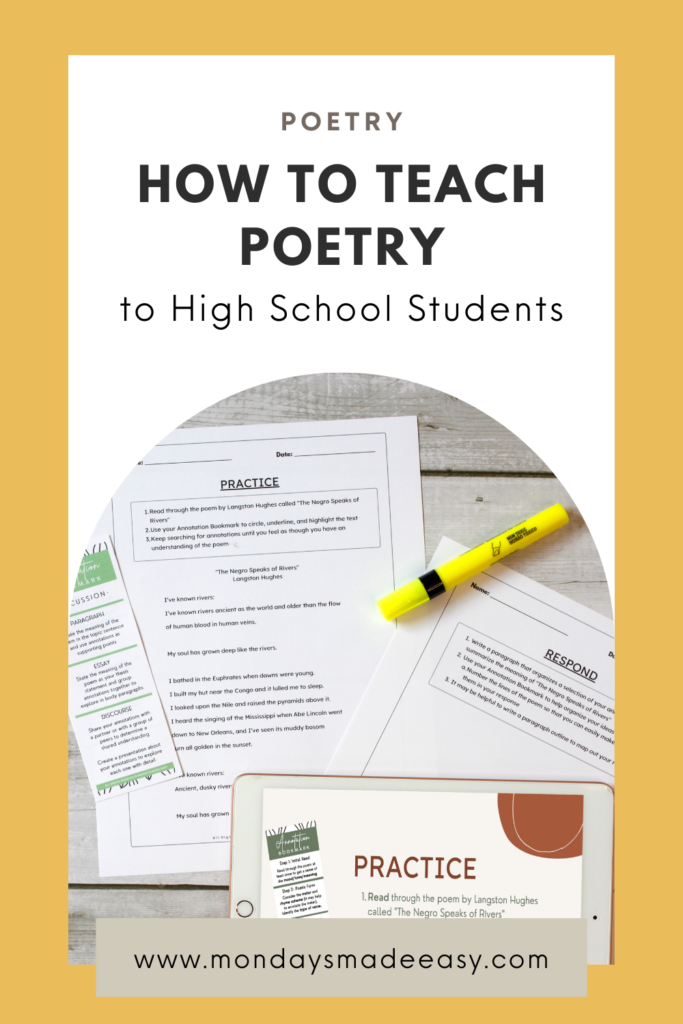
How do you introduce a poem in high school?
Have your students ever described poetry as boring or confusing? It is pretty common for them to feel overwhelmed by poetry. This is because poetry is so different from the styles of writing that they are used to exploring in the classroom. In order for students to move past this attitude towards poetry, they need to feel confident in their abilities.
To instill this confidence, it can be helpful to introduce poetry slowly . Before diving into a poem, you may want to first teach the basic elements of poetry . This will help students acquire the vocabulary that they need to discuss poetry in the classroom.
Another introductory lesson involves familiarizing students with poetic devices . Being able to identify figurative language in poetry will help students further develop their thoughts about the poem. Discussing poetic devices can also help students analyze the author’s style of writing.
Activities to teach poetry in high school
One of the most important skills for high school students is annotating . Annotating is the process of writing notes next to a verse of poetry These notes may express thoughts, questions, evaluations, or definitions. They may also note the meter (or “rhythm”) of the poem. Annotating will help students to develop an in-depth analysis of a poem.
Once students understand the elements of poetry and feel comfortable with identifying poetic devices, they are ready to practice annotating . To teach annotation, you can break the process down into steps. This blog post shares a 4-step process for annotating poetry. You can also use this free annotation bookmark as a personal anchor chart for students as they work through these four steps.
A great way to make annotating accessible to students is to practice with music lyrics . Students already have a lot to say about their favorite artists and songs; because of the cultural relevance of the music they enjoy, they often feel confident analyzing it and making inferences. Modeling annotation on song lyrics is a great way to hook your students and scaffold this skill.
This poetry unit for high school includes slideshow lessons, word wall activities, vocabulary anchor charts, bookmarks, annotation activities, and informational handouts. During this 2-week unit, students will learn how to fluently read and analyze poetry .
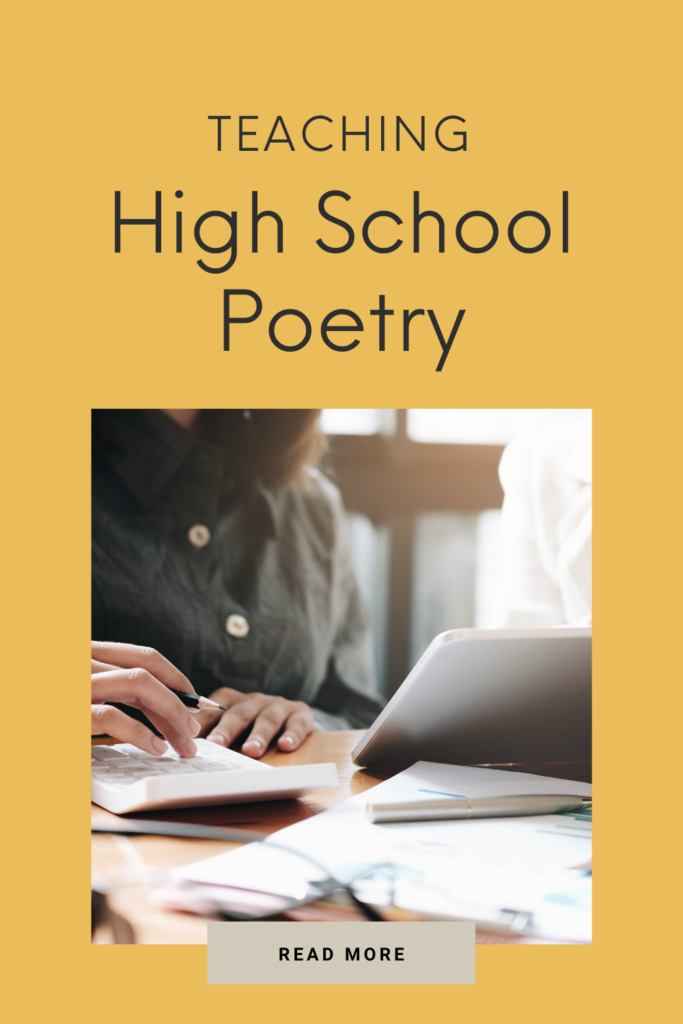
How do you make poetry fun in high school?
If there’s any unit my high school students resonate with, it’s poetry. This is because there are so many ways to make poetry engaging and fun. For the most part, my students enjoy poetry because they see it as relevant to popular culture . This is why teaching poetry in high school is so rewarding!
In order to help them see the relevance of poetry, we spend a lot of time exploring modern poets in various forms. They are especially interested in the new wave of free verse poets on Instagram , also known as “Instapoets.” Some examples of these are Rupi Kaur, Tyler Knott Gregson, and Kate Baer. Song lyrics form another connection between poetry and popular culture and serve as a great way to teach poetic devices .
Your students will probably have the most fun writing their own poetry . If they are reluctant, you could start off with a few icebreakers or creative writing prompts to help them become more expressive in your classroom. Your students might enjoy replicating the styles of free verse poetry popularized on Instagram. If so, you can lead a free verse poetry workshop with them.
If you students would prefer something more structured, then styles like sonnets and haiku might be more appropriate. Using a sonnet template or haiku outline will offer them more guidance without limiting their creativity and expression.
Best poetry for high school students
Here are a few poetry picks that your high school students will love!
Milk and Honey by Rupi Kaur – Kaur wrote this collection of poems at 21. It shares her coming-of-age experience as an Indo-Canadian woman. It is vulnerable, feminine, powerful, and features simple illustrations alongside the text.
And Still I Rise by Maya Angelou – Angelou’s collection of poetry shares the themes of strength, loneliness, and determination. The singular poem by the same name serves as a great read for an individual lesson.
“ The Negro Speaks of Rivers ” by Langston Hughes – This poem serves as a great lesson for exploring figurative language. This annotation lesson facilitates a guided close reading of the poem to teach your students how to annotate.
William Shakespeare’s Sonnets – These classic poems are a great way to explore Shakespeare’s iconic sonnet form. Students can read one of Shakespeare’s popular sonnets before writing their own using this sonnet writing workshop .
Night Sky with Exit Wounds by Ocean Vuong – Vuong is a Vietnamese American poet who recalls memories of grief and war in this full-length collection of poems. His work is a great example of contemporary poetry.
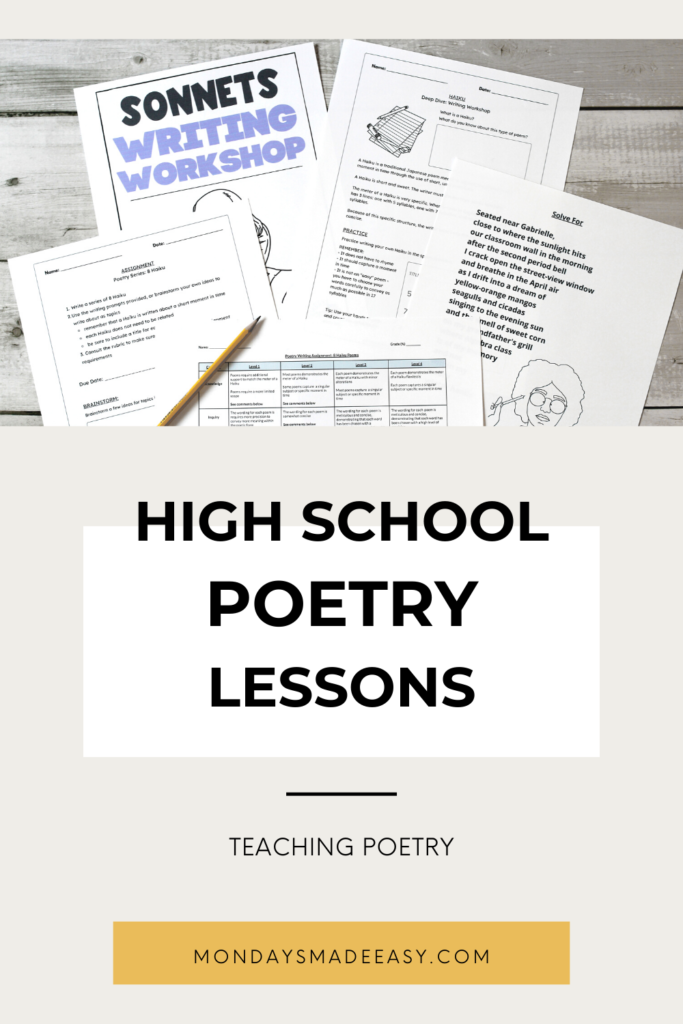
Teaching Poetry in High School: Tying it All Together
There are so many ways to make poetry fun and engaging for high school students. I hope this blog post has helped you with a few lesson plans and activities to teach poetry in high school. It’s really inspiring to see students feeling confident in reading and analyzing poetry, and it makes for great classroom conversations!
- Skip to right header navigation
- Skip to main content
- Skip to primary sidebar

15 Fun Poetry Activities for High School

April 8, 2019 // by Lindsay Ann // 3 Comments
Sharing is caring!

High School Students + Fun Poetry Activities
If you’re an English teacher, looking for fun poetry activities for high school or middle school students, I’ve got you covered. I’m opening up my poetry toolbox and sharing some of my favorite (and most successful) poetry games and activities! Whether you’re looking for a stand-alone lesson or something more, there’s something here for everyone.
Pop Sonnets
The creation of pop sonnets is one of my favorite poetry activities to use in conjunction with the reading of a Shakespearean play, but it can be used as a stand-alone lesson. The hook is that modern-day songs have been turned into Shakespearean sonnets. You can study one of Shakespeare’s sonnets and ask students to modernize it. Then, work in reverse by re-working a modern-day song as a sonnet. Or, just use this as a “hook” to help students feel more comfortable with Shakespearean language. Take a look and thank me later.
Songs as Poetry
Studying modern-day songs is a great way to teach about figurative language and poetic devices while studying poetry. Try reading the lyrics, but omitting or re-writing the metaphors and talking about the change in message/meaning. Look for examples of imperfect rhyme in one of Eminem’s cleaner songs. Study poems as paired texts . Analyze lines from a famous soundtrack. Ask students to bring in their favorite songs and discuss. So. Many. Options!
Here are 12 great songs to analyze if you aren’t sure where to start:
- “Across the Universe” by the Beatles
- “Angel” by Sarah McLachlan
- “Blank Space” by Taylor Swift
- “Chasing Pavements” by Adele
- “Infinity” by Mariah Carey
- “Stereo Hearts” by Gym Class Heroes
- “Counting Stars” by One Republic
- “It’s Time” by Imagine Dragons
- “Imagine” by John Lennon
- “Mad World” by Gary Jules
- “Zombie” by The Cranberries
- “Letter to Me” by Brad Paisley
Slam Poetry
Students need to know that poetry is not dead. It’s living. It’s breathing. It’s storytelling. It’s cool. In April, my classes come alive with the magic of slam poetry as students become authors and performers. They re-discover wonder and learn to let down their guard. They learn that there is intersectionality between their story and the stories of others. They are appreciated. They appreciate others. When I use this fun poetry activity for high school students , my classroom really becomes a true community.
Grab my slam poetry “mini” unit to get your students started with slam poetry!
Not sure which slam poems are school-appropriate and engaging? Here are 40 of my favorite slam poems !

Paint Chip Poetry
This poetry writing activity is FREE if you’re willing to grab some paint chips from your local hardware store, preferably ones with multiple colors in one. Or, Amazon sells an awesome paint chip poetry “game.”
- Have students use one of the color names as the title for a poem.
- Have students write poems in stanzas, using each of the color names as inspiration.
- Have students use all of the color names somewhere in a poem.
- Have students choose two contrasting colors and make a poem of contrasts.
- Have students choose two complimentary colors and make a poem.
- Have students choose a color and write an identity poem.
Blackout Poetry

This is an oldie, but goodie poetry writing exercise for high school students. Copy a page or two from a whole class novel. Or better yet, choose a completely divergent text, maybe a science textbook or page from a dictionary. Students string together words on the page to form a poem, and black-out the rest of the words. If they want to go above and beyond, they can create an original illustration to accompany their blackout poem.
Book Spine Poetry
Take your students to the library (or have them browse a site like Goodreads) and challenge them to create poems from book titles. Each title becomes a line in the poem. An optional challenge: have students choose (or randomly draw) a theme, and their poem has to relate to their chosen theme. If you’re looking for some FREE templates, I’ve got you covered: Click Here ! I created these templates as a quick fun poetry activity for high school sophomores after my librarian told me that having my classes pull so many books would be a pain to re-shelve.

Poetry Tasting
A lot of teachers are loving my reading progressive dinner stations . Poems are short and accessible texts that always rock when used with this activity.
Here are some options for poetry stations, a fun group poetry activity:
- Choose a certain kind of poem or a certain poetic movement to explore at ALL the stations, i.e. the ghazal or Imagist poetry.
- Choose different kinds of poems or movements to explore at each station.
- Choose poems related to ONE thematic idea.
- Choose poems written by teenagers.
- Choose “famous” poems.
- Choose slam poems.
Poetry Transformations
If you’re studying word choice and tone in poetry, why not have students transform a poem, switching from one tone to another? Then, have students write a reflection analyzing why they made 4-5 important changes.
Found Poems

This poetry activity is exactly what it sounds like. Have students choose / cut-out words from magazines to form “found” poems. Or, have students listen to a TED talk or story, writing down a certain # of words they hear. Then, ask them to use these words + ones of their own to write an original poem.
Easter Egg Poems
If ’tis the season, you might as well use those plastic easter eggs you may have lying around. Put “poetry inspiration” in each egg. At the very least, I suggest a word or phrase. If you want to go “all-in,” create a combination of the items below:
- Random household objects, i.e. a piece of string, a bead
- Newspaper/magazine clippings
- Words/phrases
- Famous first lines
- A “mentor” poem, copied and folded up
Tell students that their challenge is to write a poem inspired by these objects. Or, if you prefer, have students incorporate words / ideas from each object in their poem.
Favorite Poem Project
If you’ve never seen the site “ Favorite Poem Project ,” I suggest checking it out as a poetry unit resource. The site’s goal is to interview a variety of different people about their “favorite poems.” In each short video, an individual shares a personal connection to his/her poem and reads the poem out loud.
After being a fan of this site for some time, I decided to have my students make their own “favorite poem” videos . They explored, chose a poem that they liked “best,” and created videos on Flipgrid discussing their thoughts about the poem and reading it aloud. These videos were then viewed by classmates. Everyone enjoyed this a lot!
Metaphor Dice

Poems as Mentor Texts
Using mentor texts for writing is a powerful strategy for poetry instruction, yet one that I find myself “skipping” because there isn’t time. I have to remind myself to “make” the time because it’s important. If we’re going to spend time analyzing texts, it only makes sense to have students try to use those writing moves in their own writing. After all, students should be writing frequently, and not always for an assessment grade.
Here are 12 great mentor poems if you’re not sure where to start:
- “ We Real Cool ” by Gwendolyn Brooks
- “ Montauk ” by Sarah Kay
- “ This is Just to Say ” by William Carlos Williams
- “ Mother to Son ” by Langston Hughes
- “ My Father’s Hats ” by Mark Irwin
- “ Chicago ” by Carl Sandburg
- “ Entrance ” by Dana Gioia
- “ My Father is an Oyster ” by Clint Smith
- “ If ” by Rudyard Kipling
- “ Ode to a Large Tuna in the Market ” by Pablo Neruda
- “ The Bean Eaters ” by Gwendolyn Brooks
- “ The Summer I Was Sixteen ” by Geraldine Connolly
- “ Where I’m From ” by George Ella Lyon (As a bonus, students can submit their poems to the “I am From” project. ) p.s. If you’re looking for ready-to-use templates, here you go !
Magnetic Poetry
A fun activity to fill extra class time, or just for fun: magnetic poetry . Give each student (or pairs of students) a handful of magnetic poetry pieces. See what they come up with. Take pictures and display around the room.
Interactive Poetry Bulletin Board
Sort of like magnetic poetry, but with a twist, it’s fun to set-up an interactive bulletin board as a fun poetry activity for high school students to try before or after class. You can do this in several different ways.
- Poem of the day + a “feel-o-meter” for students to rate the poem on a scale from “mild sauce” to “hot sauce.” You can have students use push pins to vote.
- Large scale magnetic poetry + a bulletin board becomes “push pin poetry.” You choose the words. Students move them around to form poems.

Hey, if you loved this post, I want to be sure you’ve had the chance to grab a FREE copy of my guide to stream l ined grading . I know how hard it is to do all the things as an English teacher, so I’m over the moon to be able to share with you some of my best strategies for reducing the grading overwhelm.
Click on the link above or the image below to get started!
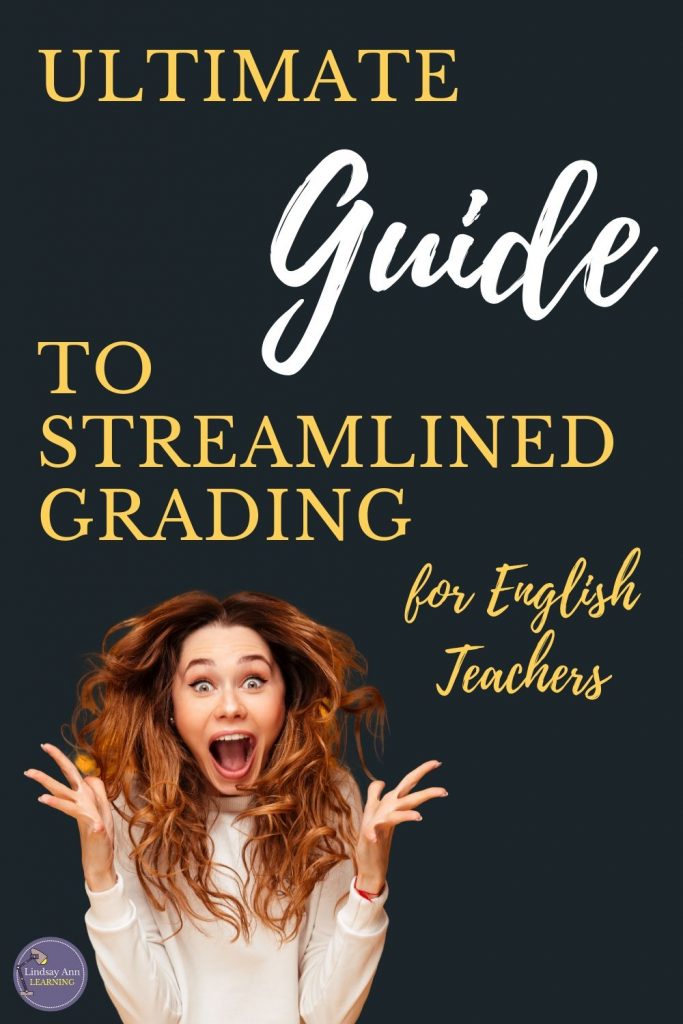
About Lindsay Ann
Lindsay has been teaching high school English in the burbs of Chicago for 19 years. She is passionate about helping English teachers find balance in their lives and teaching practice through practical feedback strategies and student-led learning strategies. She also geeks out about literary analysis, inquiry-based learning, and classroom technology integration. When Lindsay is not teaching, she enjoys playing with her two kids, running, and getting lost in a good book.
Related Posts
You may be interested in these posts from the same category.

20 Short Stories Students Will Read Gladly

6 Fun Book Project Ideas

Tailoring Your English Curriculum to Diverse Learning Styles

Teacher Toolbox: Creative & Effective Measures of Academic Progress for the Classroom

10 Most Effective Teaching Strategies for English Teachers

Beyond Persuasion: Unlocking the Nuances of the AP Lang Argument Essay

Book List: Nonfiction Texts to Engage High School Students

12 Tips for Generating Writing Prompts for Writing Using AI

31 Informational Texts for High School Students

Project Based Learning: Unlocking Creativity and Collaboration

Empathy and Understanding: How the TED Talk on the Danger of a Single Story Reshapes Perspectives

Teaching Story Elements to Improve Storytelling

Reader Interactions
[…] Dice: I wrote about this game in my previous blog post about poetry fun, but couldn’t pass by another opportunity to give it a […]
[…] you wonder how to give constructive feedback on creative writing and poetry pieces created by student writers who have put their heart and soul into […]
[…] Teach your high schoolers to annotate using poetry. Have fun with magnetic poetry online! Incorporate art, theatre, or music with black-out poetry, songs as poetry, or poetry slams. Celebrate Robert Frost’s birthday […]
Leave a Reply Cancel reply
Your email address will not be published. Required fields are marked *
Save my name, email, and website in this browser for the next time I comment.
This site uses Akismet to reduce spam. Learn how your comment data is processed .
13 Poetry Lesson Plans For High School
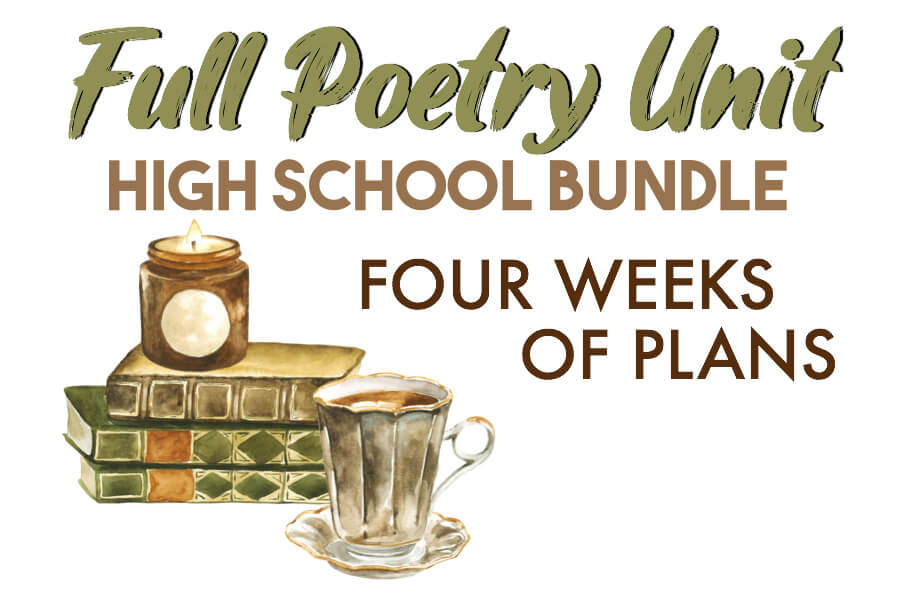
Teach your students what a poem is as well as all the important information necessary while teaching poetry, like: vocabulary, sound devices, types of poetry, figurative language, how to analyze a poem, and how to find rhyme scheme.
In this resource, you will receive a packet of graphic organizers/guided notes along with a Powerpoint lesson that teaches the following terminology:
poem, speaker, line, stanza, quatrain, couplet, cinquain, tercet, refrain, symbol, theme, mood
tone, imagery, juxtaposition, oxymoron, pun, paradox, allusion, proverb, foot, iamb, iambic pentameter, enjambment, anaphora, metonymy
FIGURATIVE LANGUAGE
simile, metaphor, personification, idiom, hyperbole, irony
SOUND DEVICES
rhyme, rhyme scheme, slant rhyme, rhythm, meter, alliteration, consonance, assonance, onomatopoeia, repetition
TYPES OF POETRY
narrative, lyrical, haiku, ballad, sonnet, limerick, free verse, acrostic, concrete, blank verse, blues poem, elegy, ode, prose, villanelle
HOW TO ANALYZE A POEM
HOW TO DETERMINE RHYME SCHEME
This resource includes a copy of the poem “The Raven” by Edgar Allan Poe and 26 close reading questions. The analysis includes an in-depth look at academic vocabulary, poetic devices, and literary elements in the poem. (An answer key is also provided.)
Poetic and Literary Devices Covered in this Activity:
alliteration
- rhyme scheme
- gothic literature
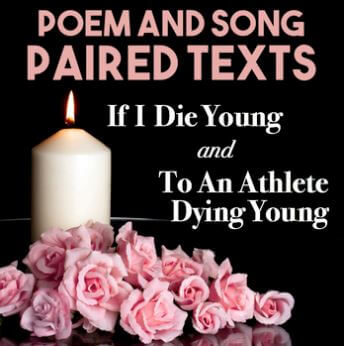
In this poetry analysis activity, your students will read and answer questions regarding the famous poem “To an Athlete Dying Young” by A. E. Housman. Next, your students will listen to the song “If I Die Young” by The Band Perry that carries a similar message. Then, students will take a closer look at how these two texts relate. Comparing and contrasting these paired texts will help your students better understand point of view, tone, mood, and theme! Add music to make poetry fun for students! This resource includes:
- Full text of the poem “To an Athlete Dying Young” by A. E. Housman
- Analysis questions for the poem “To an Athlete Dying Young”
- Song analysis questions based on the lyrics “If I Die Young” by The Band Perry
- Compare and contrast question about the song and poem
- EDITABLE copy of the questions so you can make modifications if needed
- ANSWER KEYS for everything
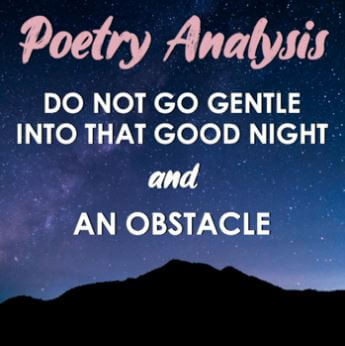
In this Paired Texts Poetry Analysis , your students will analyze the two poems: “An Obstacle” by Charlotte Perkins Gilman & “Do not go gentle into that good night” by Dylan Thomas.
This resource includes:
- Full text of “An Obstacle” by Charlotte Perkins Gilman (Due to copyright law, I am unable to provide a full text of the poem “Do not go gentle into that good night” by Dylan Thomas)
- Graphic Organizer that closely examines both poems for: meaning, tone, figurative language, setting, imagery, and theme (PDF)
- Answer key for poem analyses
- Constructed Response task which requires students to develop an answer in paragraph form. (The first CR question asks students to compare the themes in each poem. The second CR question requires students to personally connect with the theme.)
- Editable copy (word document) of the poetry analysis graphic organizer
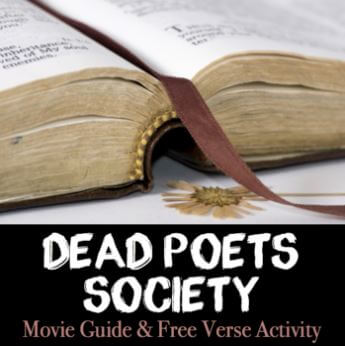
As your students watch the 1989 Film Dead Poets Society (directed by Peter Weir), have them answer these film analysis questions to help them better comprehend and understand the film’s meaning and purpose. Additionally, have them personally connect to the theme of the film by writing their own free verse poem in response to Walt Whitman’s poem “O Me! O Life!” The film is 2 hours and 8 minutes in length.
Included in this lesson:
- 22 Comprehension and Analysis questions based on the film “ Dead Poets Society” — these questions require students to connect to the characters in the film and use inferencing skills
- Answer key to the film’s analysis questions
- Free Verse Writing Activity: prompt and rubric in response to Walt Whitman’s poem “O Me! O Life!”
- Editable copy of the lesson for teachers to make modifications if needed
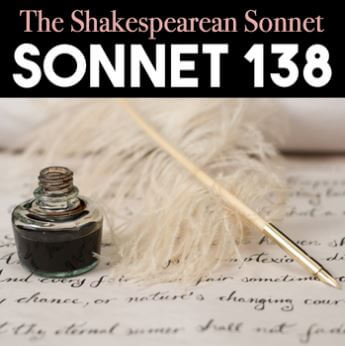
Teach your students all about Sonnets with a unique analysis of William Shakespeare’s Sonnet 138.
1) First, use the Powerpoint presentation to familiarize your students with:
- Sonnet definition and structure
- Shakespearean Sonnets
- Petrarchan Sonnets
- Spenserian Sonnets
- Miltonic Sonnets
- Iambic pentameter
- Two-part thematic Structure
- Rhyme Scheme
Guided notes worksheet included!
2) Then, have your students analyze Shakespeare’s Sonnet 138 by answering comprehension and literary analysis questions. Answer key included!
3) Lastly, have your students write their own original Shakespearean Sonnet . Directions and guidelines included.
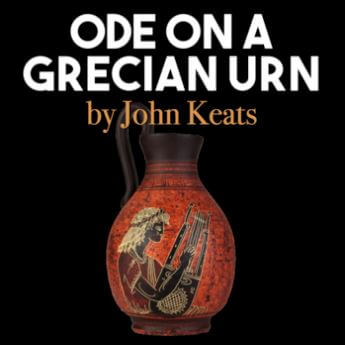
Students will read and analyze the famous poem by John Keats, “Ode On A Grecian Urn.” This resource is great for any poetry unit!
This lesson includes:
- Full text of the poem “Ode On A Grecian Urn”
- 14 Questions about the poem: a mix of comprehension and literary analysis questions
- Write Your Own Ode Poem Activity for Students (Directions and Requirements)
- EDITABLE Word Document so you can make modifications if you wish to
Teach your students all about Blackout Poetry with this fun lesson and activity!
In this resource, you will receive:
- Teacher Guide
- Powerpoint lesson on Blackout Poetry with step by step directions for students to create their own blackout poems in a variety of ways
- 10 Examples of blackout poems
- 40 Pages of printable texts your students can use to make their own poetry
- Editable word document Rubric and Prompt for students
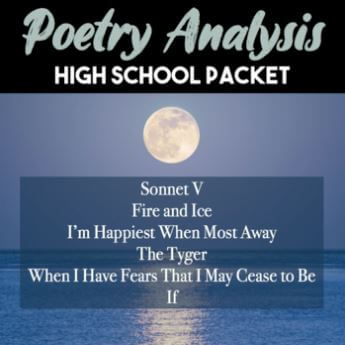
In this High School Poetry Packet , your students will read, study, and analyze six famous poems! Perfect for any Poetry Unit!
This packet is a wonderful tool because you can have students complete the literary analysis questions in a variety of ways: whole-class, independently, or collaboratively.
The 6 poems included in this packet are:
- Sonnet V by Shakespeare
- “Fire and Ice” by Robert Frost
- “I’m happiest when most away” by Emily Brontë
- “The Tyger” by William Blake
- “When I have Fears That I May Cease to Be” by John Keats
- “If” by Rudyard Kipling
In this packet, students will work on poetry skills such as: rhyme scheme, rhyme, imagery, assonance, consonance, caesura, anaphora, alliteration, theme, tone, mood, personification, enjambment, connotation, and more.
Your students are going to love this Poetry Digital Escape Room! Students will read and analyze the poem “Stopping by Woods on a Snowy Evening” by Robert Frost.
They will solve puzzles in this peaceful scene of snowy woods, glistening mountaintops, and a beautiful, serene frozen lake. In this 360° digital escape room, students will try to escape the woods before the sun goes down! This activity is designed to work for a laptop, tablet, or smart phone.
This game requires reading comprehension strategies, knowledge of poetic devices, and critical thinking skills. Watch the preview video and see exactly what’s inside the digital escape room!
Included in this download are teacher instructions, student instructions (digital), the master lock graphic organizer, answer keys, the full text of the poem, and a reflection sheet (optional).
Assign your students a one pager poetry analysis project and have your students share their understanding of ANY POEM by imaginatively blending their written ideas with colorful images from the text. You can pick one poem for your whole class to use or have all your students pick their own individual poems! Students’ artwork make for unique and creative analyses of the literature and also make great bulletin boards!
Included in this purchase is:
- Student directions for the one pager project
- Rubric for the one pager project
- Example one pager (based on the poem “Do Not Go Gentle Into That Good Night” by Dylan Thomas)
- 10 BLANK TEMPLATES (printable — optional)
- EDITABLE word document so teachers can modify instructions or rubric
Students are encouraged to include several of these literary devices, poetic devices (sound devices), and figurative language elements into their final projects: metaphor, simile, personification, hyperbole, imagery, pun, oxymoron, paradox, idiom, allusion, symbolism, assonance, consonance, alliteration, anaphora, rhyme, rhyme scheme, repetition, onomatopoeia, cacophony, mood, tone, and theme.
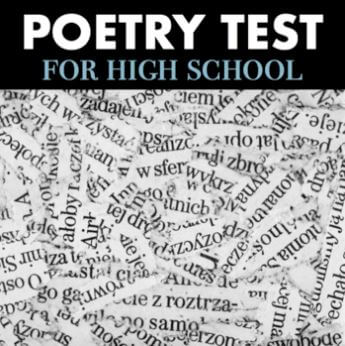
This resource includes a Poetry Assessment for high school students (9th-12th grade ELA). You will receive a printable PDF copy of the test as well as an EDITABLE word document in case you would like to make modifications. A detailed answer key is also included!
The format of this test includes:
- 10 fill-in-the-blank questions with a word bank
- 8 matching questions with poem types
- 5 matching questions with sound devices
- 7 matching questions with figurative language
- A poetry analysis of two poems: “A Psalm of Life” by Henry Wadsworth Longfellow and the Sonnet “Death, be not proud” by John Donne.
- Students will answer 5 multiple choice questions regarding each poem
- 1 constructed response where students will compare the themes of each poem in a minimum of two fully developed paragraphs
(41 questions in total including the written response)
The Poetry Test covers the following literary terms:
narrative poem
lyrical poem
onomatopoeia
personification
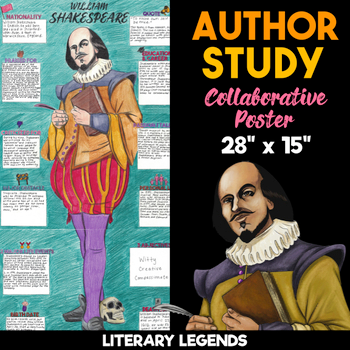
Have your students create a collaborative poster and learn about William Shakespeare in a fun and engaging way!
Your students will create an author biography by researching Shakespeare and establishing his profile on a poster.
Students will learn about Shakespeare and his body of work as an influential author.
Additionally, they will learn the importance of collaboration and effective communication. This project is perfect for National Poetry Month.
Project Steps:
1) To construct the author study poster, your students will work in groups to conduct research on Shakespeare.
2) Students will then transfer their findings to boxes on the poster.
3) Next, they will work together to color or paint the pieces of the poster.
4) Lastly, students will tape together the final product.
The poster is made up of six pieces of paper, which can be printed on regular copy paper or card stock.
Once taped together, the final product will be 28″ x 15″ and can last a lifetime if you laminate it!
This resource includes the following:
- Step by Step Student Directions (PDF & editable word document)
- Author Study Project Rubric (PDF & editable word document)
- Author Study Graphic Organizer for Students (PDF & editable word document)
- 6 Blank Coloring Pages that come together as one beautiful poster (PDFs)
- William Shakespeare Author Study Answer Key
- Example of Final Project: Completed Text & Fully Colored Body
Check out more from my LITERARY LEGENDS Collection:
- Emily Dickinson
- Langston Hughes
- George Orwell
- Robert Frost
- Walt Whitman
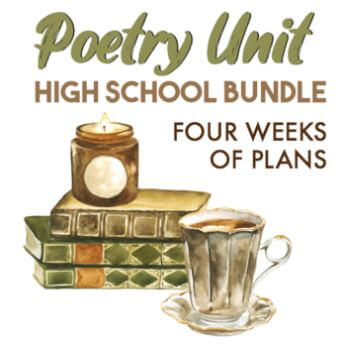
This resource is a FULL POETRY UNIT for High School English, Grades 9-12!
You will get a collection of various lessons, activities, and projects, plus an awesome digital escape room, and final test! I’ve also included a schedule for teachers to follow day-by-day! This bundle is so diverse and your students will read at least 18 different poems within this unit!
Included in this high school poetry unit bundle:
- Introduction Poetry Lesson & Guided Notes
- The Raven by Edgar Allan Poe Poem Close Reading
- To an Athlete Dying Young by A. E. Housman & Song Comparison Activity
- Do Not Go Gentle Into That Good Night & An Obstacle Paired Texts Analysis
- Dead Poets Society Movie Guide & Free Verse Poem Writing
- Sonnet 138 William Shakespeare, Sonnet Lesson & Writing Activity
- Ode On A Grecian Urn | Poem by John Keats & Ode Writing Activity
- Blackout Poetry Lesson and Creative Art Project
- Poetry Packet: Analysis of 6 Poems
- Poetry Digital Escape Room using Robert Frost Poem
- Poetry One-Pager for ANY POEM
- Editable Poetry Test with Answer Key
- William Shakespeare Author Study: Collaborative Poster Project!
- Teacher guide with day by day schedule for 4 weeks of Poetry
Leave a Reply Cancel reply
Your email address will not be published. Required fields are marked *
Save my name, email, and website in this browser for the next time I comment.
Poetry Center

Five Creative Writing Lesson Plans for Middle & High School Students
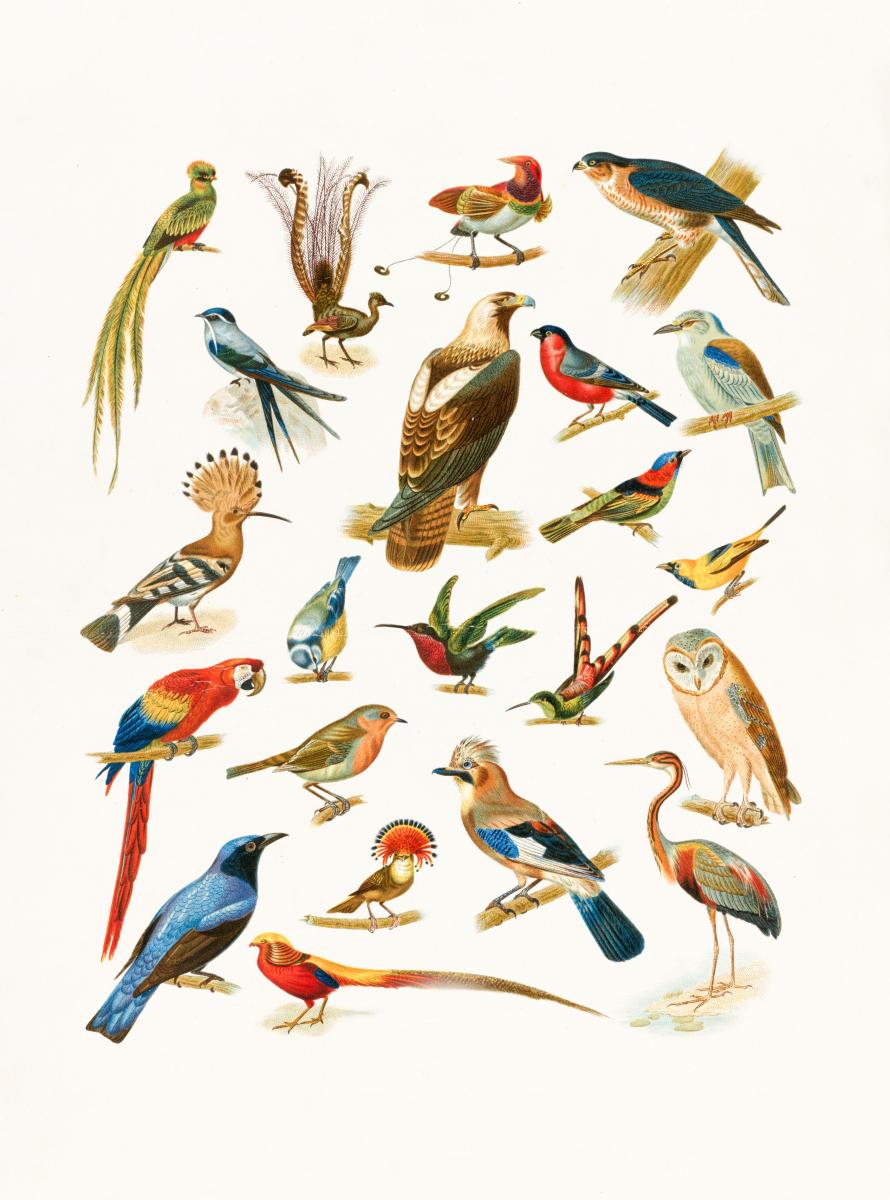
A Poem About Joy:
In this lesson plan, inspired by Ross Gay's "Sorrow Is Not My Name," Teré Fowler-Chapman asks young poets to come up with a list of things that bring them joy and then write a poem inspired by one of the items on that list. The writing exercise, which is a fantastic way to bring social-emotional learning into the classroom, is preceded by a conversation on Gay's poetics and on how joy can exist even in times of sorrow.
Personal Migrations:
Saraiya Kanning, inspired by Wang Ping's "Things We Carry on the Sea," asks young writers to, "contemplate how migration has played out in their own lives, including the lives of their families." This multi-part lesson plan includes a word association game, a discussion of Ping's poem, and a group poem in which students answer the question, "What sort of things have been carried across land, sea, or even across time?" collaboratively. After this, they write their own individual poems, using a series of questions to jump start their creativity, and then craft art pieces using popsicle sticks, pipe cleaners and/or puff paint to trace paths across the surface of their chosen canvas (Kanning used cake board!). This lesson can be shortened or spread out over class periods as part of a unit on immigration and migration.
Rare Bird Erasure:
"Erasure poems use words from another source to create a new poem," Saraiya Kanning writes in this lesson plan, which uses the field guide Rare and Elusive Birds of North America as a source text from which young writers create their own pieces (although you're welcome to use any book you'd like!). Each student receives a photocopied page from the book and goes on a "treasure hunt," selecting 5-10 words that in some way connect to one another. After creating their erasure poem, students can decorate the page with art materials to "create images, patterns, or designs around the words." This lesson plan includes a note on modifications for student with visual impairments.
Titles: Art on their Own:
So often in creative writing, the titling process is overlooked but important: as Sophie Daws says, "Writing a title can feel like putting the cherry on top of your great poem or it can feel like walking on eggshells, where the wrong title could ruin the whole poem and you just can’t come up with the right one!" This lesson plan, drawn from her high school zine residency, uses six prompts to offer a guided approach to coming up with a title for a finished project, from one that asks students to write down their favorite line to another that encourages them to think of how a title can add another tone or angle to their work.
Found Art Handmade Books:
Taylor Johnson bridges creative writing and visual art in this lesson plan, which focuses on crafting handmade books from recycled materials. Johnson suggests using everything from old postcards to yarn to insect wings to create a publication that's truly one of a kind. As far as words go, students can either add something they've previously written to their books whole cloth or cut up bits of their old writing and "remix" it. After the books are done, Johnson suggests creating a classroom library or exhibit for students to browse one another's books.
Image from the Boston Public Library.
Category:
Tags: .
- writing the community
ELA Brave and True by Marilyn Yung
Nine Poetry Ideas for High School

Get creative with these nine poetry lesson ideas
Need a new poetry idea? If there’s one thing poetry can give you it’s this: variety in your ELA lessons. Read this post to learn how to add more variety to your classroom with these nine poetry ideas that I’ve pulled straight from my lesson plans for my new poetry class.
For background, I’m teaching a new poetry class this year. The class meets during seventh hour (the last period of the day) and is open to juniors and seniors, and sophomores with approval. When students enrolled for their classes last spring during arena scheduling, I hoped to have half a dozen students sign up. I was wrong. EIGHTEEN students visited my table and got their name on the roll. Wow! What a great thing!
And so far, this class is my absolute favorite one of the day.
I have an unabashedly creative group of students who, for the most part, truly appreciate the beauty of words and have a penchant for enjoying the challenge of a new poetic form each week.
Below, I’ve listed the various poems this awesome group has written so far this fall. Perhaps one or more of these will be new to you and might give you some ideas for your own class.
Side note: I plan to publish longer posts on some, if not all, of these individual poem projects. Follow my blog or become a subscriber at the bottom of this page to catch those posts.
But for now, I hope the ideas below will inspire you to try these within your own larger poetry unit, or simply as a refreshing creative writing activity.

Nine poems for your ELA classroom
- This poem is one you must try. It’s inspired by a poem written by award-winning poet, essayist, and journalist ( The New Yorker, The Atlantic , and more) Clint Smith . With this poem, Smith takes a concrete topic (a hermit crab) and transforms it into a discussion on an abstract idea (our personal vulnerabilities and how we deal with them). You will be AMAZED with the poems your students will write with this Clint Smith classic. Go here on American Poetry Review to read the poem now.
- Students crafted lists on any topic. This one was really fun and revealed so much about the personalities of my students. The mentors we used included Daily by Naomi Shihab Nye and Common Things by Ivor Gurney.
- Students wrote on a simple theme: silence. That was it. It was broad enough but also gave a direction for students to travel in verse. I love providing a general idea to a group of students and seeing how they each have a unique response to it. This poem idea was number 24 (Sound of Silence) on this page on ThinkWritten.com.
- This one rocked AND rolled. Students mastered this five-line form built on a 2-4-6-8-2 syllable count. Read here for my Cinquain post titled “Poetry Lesson: The Cinquain” to get the whole story. Please make sure you try cinquains.
- This was simply another poem on a given theme: cold water. Not warm, not hot, but cold. Again, interesting results abounded all around. Thanks to idea number 9 from this page on ThinkWritten.com.
- Think of these as tribute poems to something unexpected. Great fun! Yes, we talked about formal structures such as Platonic and Horatian odes, but we wrapped up with contemporary odes, which can be free verse, unrhymed, and primarily celebrate the unexpected. Here are the mentors we used to get familiar with contemporary odes: Lucille Clifton’s “homage to my hips” (we watched this video of Clifton reading it) and Kevin Young’s “Ode to the Midwest.”
- Villanelles were our second foray into a strict structure. My students gave villanelles the ol’ college try, but also felt a little too constrained. Adhering to the strict form definitely hindered creative expression. I passed out two mentors (Dylan Thomas’ Do Not Go Gentle Into That Good Night) and and asked students to figure out the form and structure on their own or with a partner. We also noticed and graphed out the rhyme scheme with this one. I also provided a villanelle guide sheet to help them imitate the structure more readily.
- With the help of Taylor Mali’s Metaphor Dice, we created verses built around incredible metaphors provided to us with the roll of the die. Since the dice determined our metaphors, I decided to not place any additional requirements on their metaphor poems beyond that they needed to be at least eight lines in length.
- This Poetry Daily email featuring this poem by Peter Filkins inspired this easy poem idea: write a poem about an animal (see what I mean by simple?!). Filkins’ poem did have some new vocabulary to learn (panzer) and we marveled at its use of metaphor and alliteration. My students decided that we should write at least ten lines for this poem and I asked them to include at least one use of alliteration. I found a couple more mentors: Woodchucks by Maxine Kumin and The Crocodile by Lewis Carroll.
Try any or all of these poem ideas, and you’ll see students connect better with all things ELA if you do. According to Andrew Simmons in “Why Teaching Poetry is So Important” in The Atlantic , “…poetry enables teachers to teach their students how to write, read, and understand any text.” In my experience, poetry shows students that they can write and think creatively and in fresh, spontaneous ways. That’s so important.
I would also venture to say that the benefits of poetry are best seen when students write more than one or two poems per school year. They need to write several, if not many! Enter poems or poetry as a keyword in the search bar below to find even more poetry ideas from my blog. Have a great week!
Search my website for more ideas!
Need another poetry idea.
Enter your email below and I’ll send you this PDF file that will teach your students to write Treasured Object Poems , one of my favorite poem activities. I know your students will enjoy it!

By clicking submit, you agree to share your email address with me (the site owner) and Mailchimp to receive occasional emails (and I do mean occasional… like every other month or so). I only send you articles I think you’ll really benefit from. Obviously, you can use the unsubscribe link in those emails to opt out at any time.
Yet one more poetry idea!

A New Poetry Idea B lends Movie Subtitles and Text: The Great Gatsby
My New High School Poetry Class

ELA Brave and True | Love teaching. Make it memorable.

Feature photo credit: Alex Perez on Unsplash
Share this:
- Click to share on Twitter (Opens in new window)
- Click to share on Facebook (Opens in new window)
- Click to share on Pinterest (Opens in new window)
- Click to print (Opens in new window)
- Click to share on LinkedIn (Opens in new window)
- Click to email a link to a friend (Opens in new window)
Published by Marilyn Yung
Writes | Teaches | Not sure where one ends and the other begins. View more posts
4 thoughts on “ Nine Poetry Ideas for High School ”
- Pingback: Three poem ideas for Veterans Day – ELA Brave and True by Marilyn Yung
- Pingback: Taylor Mali’s Metaphor Dice – ELA Brave and True by Marilyn Yung
- Pingback: Ukrainian Poetry: Words for War – ELA Brave and True by Marilyn Yung
- Pingback: Creative high school poetry idea: Poetic Art – ELA Brave and True by Marilyn Yung
Leave a Reply Cancel reply
Discover more from ela brave and true by marilyn yung.
Subscribe now to keep reading and get access to the full archive.
Type your email…
Continue reading
Expect Unexpected Engagement When you try Hexagonal Thinking in ELA
Listen to my latest podcast episode:.

Wish you could teach students to podcast without the tech hassles? Join us for Camp Creative June 10-14!
Pop into my free summer pd camp on your schedule, and walk away with top show recs, listening activities, and four different podcast projects..

Creative Poetry: Ideas, Activities, and Prompts for High School ELA
- March 28, 2023

Are you always wondering how to squeeze more poetry ideas into your curriculum? I hear you! A dedicated poetry unit is lovely, but poetry is also a wonderful option to pair with other texts, use in between units, or simply sprinkle into moments when you have some time and would like to do something creative to help kids develop their writing and thinking in a fresh way.
Today we’re exploring nine options for the next time you’re thinking poetic thoughts – and did I mention April, National Poetry month, is write (ha ha) around the corner?
Classroom Poetry Idea: Write Lipograms
This month I’ve been collaborating with the amazing Melissa Alter Smith over at Teach Living Poets to work on contemporary poetry activities for The Lighthouse. I love her post, “ Letter Play ,” sharing ways to get students thinking about how to use different letter structures in their poems.
For example, notice anything strange about this quick poem I wrote?
“She entered. The empty felt endless. The end.”
If you noticed it only uses a single vowel, you nailed it! Despite my forty years of devotion to English, I had never heard of a lipogram until Melissa introduced me to them this month, but now I think they’re such a cool form!
Check out this great mentor text Mel shared with me, Cathy Park Hong reading her poem, “Ballad in O.” You can use it with your students as a model before diving into a pop-up writing workshop with them.
Before diving into lipogram creation, you’ll want to do some activities to help students start thinking about letters and brainstorming word options. I always think of Eileen Landay from Brown University, who spoke on the podcast about helping students create “thick air” with activities that would help them come to any creative activity with lots of ideas.
For lipograms, you can let students brainstorm words with a single vowel of their choice inspired by images, specific words, videos, colors – anything you want! You can use the prompts pictured below ( make your copy here ).

Once they’ve got lists of word ideas, you can let them create their poem on any theme they wish, or ask them to write based on whatever you’re doing in class. Maybe their poem will be from the perspective of a character in your current book or explore a moment in their choice reading book. Or maybe they’ll search through a book with powerful images or online photo gallery and pair their poem with an image that inspires them.
Classroom poetry idea: try digital poetry tiles.

You know I love drag-and-drop poetry tiles to help take the fear out of writing a poem. There’s nothing like having all the words down on the page already to help eliminate writers’ block.
Students simply drag the titles around, add words they want using blank tiles, and eliminate the rest. It’s easy and fun, and students can share their final products in a class slideshow at the end of the workshop. I just made some new tiles you can use in April as Ramadan ends, for the holiday of Eid (click to make a copy), or you can explore all my poetry tiles on TPT here, like the examples from the spring set below.

Classroom Poetry Idea: Enjoy Blackout Poetry on Paper or Online

Blackout poetry is such a powerful (and EASY) form! I just wrote a fun step-by-step for We are Teachers you can read here , and I created a full kit to help you try it out digitally or on paper. You can sign up for all the free materials pictured below (and more) here.

Don’t worry if you don’t have spare books to rip up, the activity is really wonderful online too, or you can simply print the book pages from classic texts freely available to the public that I’ve added to the kit.
Classroom Poetry Idea: Write I am From Poems

I love the “I am from” poem. At some point fifteen years ago I stumbled across the idea of having students write these poems, inspired by George Ella Lyon’s poem, “Where I’m from” (l isten to the audio ) or ( read the text ). Lyon weaves together vivid images from her life as a girl, drawing on little things like art projects she did, products she used, things her parents said, as well as sensory details from her life experience, to create a window into her past. It’s a striking poem, and also an easy one to understand and to emulate (perfect for class!).
If you’re intrigued, check out this post for a full walkthrough how to use this beautiful form in class.
Classroom Creative Poetry Idea: Stack Book Spine Poetry

Book spine poems are such fun! If your librarian is feeling flexible, you can take your students on a field trip to the library at your school and let them create using actual books. They simply stack the books to create a poem out of the titles, then snap a photo and put all the books back exactly where they found them!
You can also do this activity digitally. I’ve created slides full of books for you ( click here for your copy ). All you need to do is make copies for your students and let them drag, drop, and delete.
Fun, right? Not intimidating at all! Letting students explore many forms of creative poetry workshops can help poems feel friendly to them instead of terrifying.
Classroom Creative Poetry Idea: Share More of Amanda Gorman
OK, you’ve likely heard of and probably taught New Day’s Lyric and/or The Hill We Climb. ( But if you haven’t, check out this podcast! ) But there is so much more Amanda Gorman out there to explore.
Maybe your students could create short videos to go with a performance piece as the audio, using Gorman’s “Earthrise” as a mentor text. Or maybe it could inspire a project about using multiple modes to share a message.
Maybe they could write poems about a leader/hero.athlete they admire in the style of this poem Gorman created for Simone Biles.
Did you know Amanda Gorman has also written a children’s book? I loved hearing from Pernille Ripp last year about all the ways children’s books can be folded into our curriculum for older kids. Change Sings could be a great text to use within one of your other units.

First Chapter Friday Features: Novels-in-Verse
Have you explored novels-in-verse with your students? They can be a wonderful on-ramp into books. Check out this opinion piece from Jason Reynolds below.
One way to introduce verse novels to your students is by featuring them in your First Chapter Friday program. Long Way Down and The Crossover could be good places to start, though there are many more out there to choose from.
Never heard of First Chapter Friday? Start here.

Feature Poetry Themes in your Book Displays

Last but not least, if you’re looking to get students excited about poetry, feature it in your book displays and on your walls. Hang favorite poems on your Cordel , feature poetry collections covers out on your shelves, create a display featuring novels-in-verse, poetry collections, and even related children’s books.
OK, that’s all for today! I hope you’ve found some creative poetry ideas you’re excited to get started with.
Looking for more creative teaching inspiration? Subscribe to The Spark Creativity Teacher Podcast on Apple Podcasts here , and find 150+ workshops and interviews to bring you creative options you can use immediately.

I’ll help you find the creative ELA strategies that will light up your classroom. Get ready for joyful teaching!
LET’S BE PEN PALS
Browse by category.
SEARCH FOR THE STRATEGY OF YOUR DREAMS, OR DIVE INTO ONE OF THESE POPULAR CREATIVE RABBIT HOLES.

POPULAR POSTS

The ELA End-of-Year Checklist for a Better August

The Easiest Last Day in ELA

3 Years Overseas: The Highs & Lows of living abroad (as we prepare to say goodbye)

Need something great for tomorrow? Head on over to the free resources section.
Let’s hang out on

- PRIVACY POLICY
- TERMS AND CONDITIONS
Privacy Overview
| Cookie | Duration | Description |
|---|---|---|
| cookielawinfo-checkbox-analytics | 11 months | This cookie is set by GDPR Cookie Consent plugin. The cookie is used to store the user consent for the cookies in the category "Analytics". |
| cookielawinfo-checkbox-functional | 11 months | The cookie is set by GDPR cookie consent to record the user consent for the cookies in the category "Functional". |
| cookielawinfo-checkbox-necessary | 11 months | This cookie is set by GDPR Cookie Consent plugin. The cookies is used to store the user consent for the cookies in the category "Necessary". |
| cookielawinfo-checkbox-others | 11 months | This cookie is set by GDPR Cookie Consent plugin. The cookie is used to store the user consent for the cookies in the category "Other. |
| cookielawinfo-checkbox-performance | 11 months | This cookie is set by GDPR Cookie Consent plugin. The cookie is used to store the user consent for the cookies in the category "Performance". |
| viewed_cookie_policy | 11 months | The cookie is set by the GDPR Cookie Consent plugin and is used to store whether or not user has consented to the use of cookies. It does not store any personal data. |
Leave a Reply Cancel reply
Your email address will not be published. Required fields are marked *
Save my name, email, and website in this browser for the next time I comment.
Ethical AI PBL Unit
3 weeks of attendance questions, better discussion toolkit.

Almost there!
Trending Post : 12 Powerful Discussion Strategies to Engage Students

9 Fun Poetry Lessons to Add to Your Next Unit
Did you land on this post while searching for ways to make poetry less painful…more exciting…more interactive…more creative? Maybe you’re starting your first poetry unit, or maybe you need a way to engage students who claim to dislike it. In this post, you’ll find nine fun poetry lessons for secondary.
1. Creative Writing
Help students study the importance of text structure as they write nonfiction-inspired poetry. Try blending elements of prose, verse, picture books, and concrete poetry to help students understand the power of word choice and aesthetics.
This would also be an opportune time to fit in the concepts of rhythm and rhyme. Studying how words are arranged can help students understand the impact of author’s craft on the overall reader’s experience.
In this activity, students read a nonfiction text (selected by you or by them!), identify their key takeaways, and respond creatively using poetry! Read more about this lesson plan here .
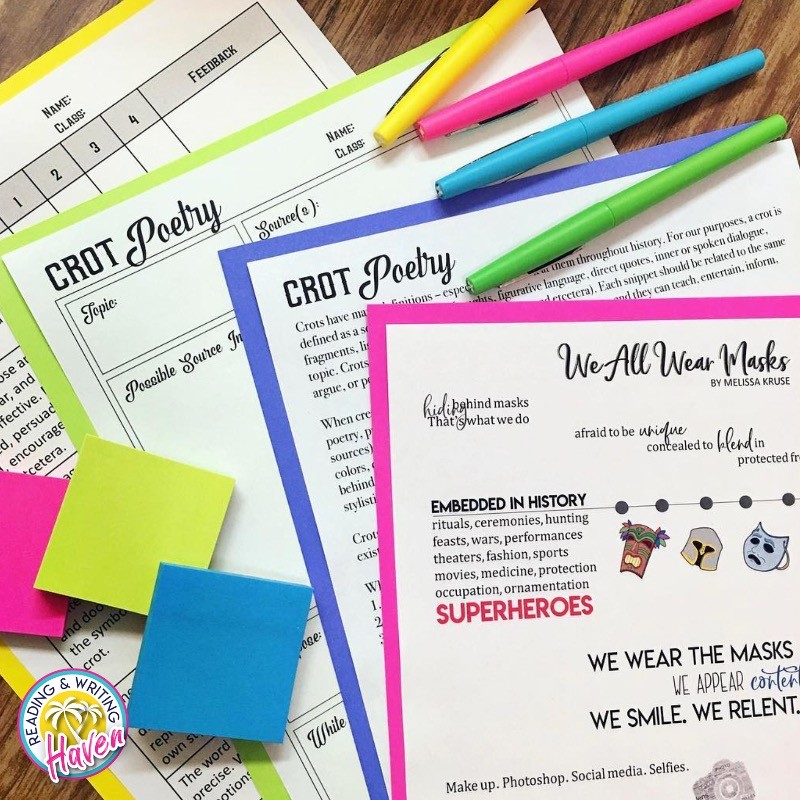
2. Music Analysis
Poetry lessons wouldn’t be complete without music lyric analysis!
I incorporate music into every poetry unit because it makes the genre more relevant to reluctant students. Reading poetry is an opportunity to practice analysis and annotation skills. Songs change in popularity, and each class has a different culture, which should be taken into consideration when selecting music.
One of my favorite lessons using poetry is when I introduce the presence of figurative language in verse with the song “ My Heart’s a Stereo .” It’s a fun way to explore the concept of an extended metaphor. Follow up this lesson with the poem “All the World’s a Stage,” which is part of As You Like It.
Use this free song analysis activity to guide your discussion.
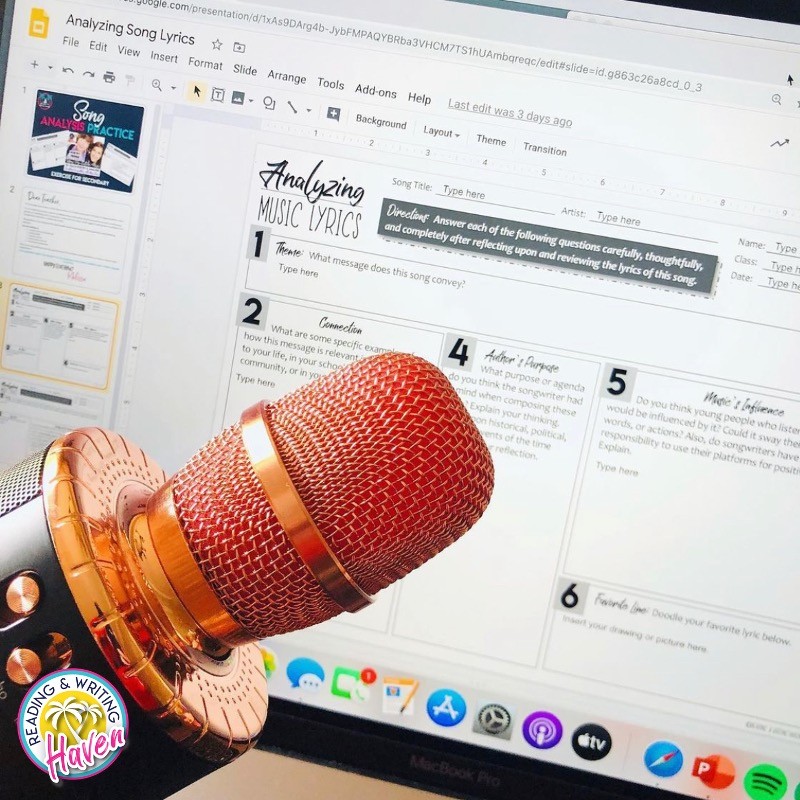
3. Mood and Tone
Mood and tone can be difficult concepts for students to grasp. I try to re-visit the concepts multiple times throughout the year with various types of literature.
Visuals help! For example, analyze mood and tone by comparing the way the author plays with word choice to the way an equalizer adjusts the sound frequencies of a song.
This engaging poetry lesson requires students to think critically and symbolically about how mood is represented by color and how tone is controlled through the equalizer. The poet’s diction is the focal point of this creative task, which can be applied to any poem. Want a recommendation? Try using it with “The Highwayman.”
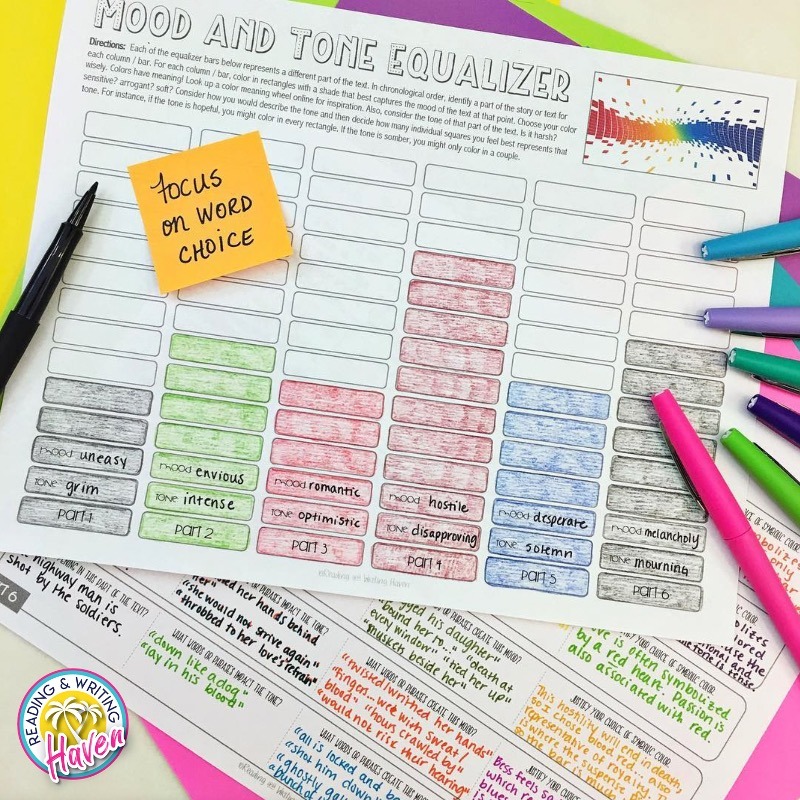
4. Picture Inspiration
Want students to write poetry? Pictures are an excellent hook. Previously, I wrote about 13 ways pictures can inspire students to write poetry . You can find detailed ideas in that post.
Consider: wordless picture books, old family photos, cartoon strips, social media. Texting couplets are also engaging. The possibilities are inspiring.
Download the picture-based poetry resource featured below to help differentiate poetry writing for your students.
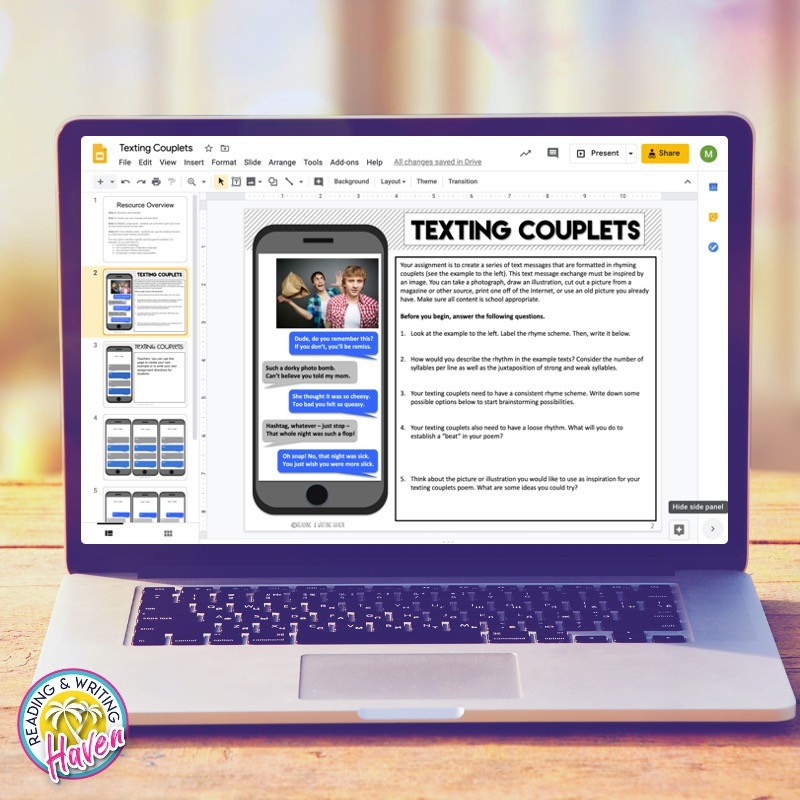
5. Close Reading
Looking for more traditional poetry lessons? Sometimes we kill a poem by asking students to read it and analyze it for everything under the sun. I’ve had more luck with close reading and poetry when I focus on one specific target.
With this lesson , students read and re-read short poems, analyzing them through a specific lens. For instance, how does the poet’s word choice impact the reader’s overall experience? How do the connotations and denotations of important words establish the mood?
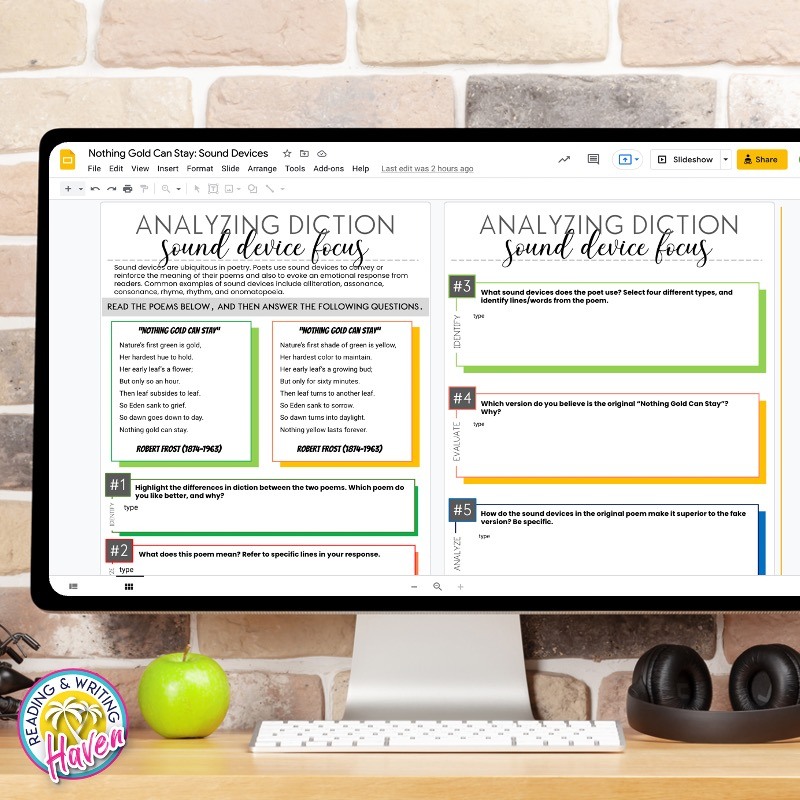
6. Paired Texts
Surprise your students by pairing poems with nontraditional texts, like short films. Here are five recommended pairings to get students thinking. What I love about this poetry lesson is how it incorporates diverse perspectives, which increases the rigor. As a result, students typically come up with some impressive responses.
Students enjoy poetry more when they can connect the themes to their own lives and to other modern literature. That’s an important benefit of approaching poetry through a paired-text analysis approach.
7. Play Games
Once students have been introduced to the terminology you are using during your poetry unit, don’t be afraid to give them a poem and turn them loose with a game. It’s a social way to think critically about a poem, and as they talk, you have the freedom to roam around and overhear common misconceptions. In doing so, you’ll have a better idea of what concepts might require a follow-up lesson.
This poetry challenge covers structure, figurative language, types of poems, and sound devices. Students can play it with many different poems. Not sure they’re ready for independent play? Play as a class by projecting the game and dividing the students into groups.
Looking for a figurative language game students can use to practice literary terms? Try figurative language Truth or Dare , or, for a more advanced class – Get Schooled !
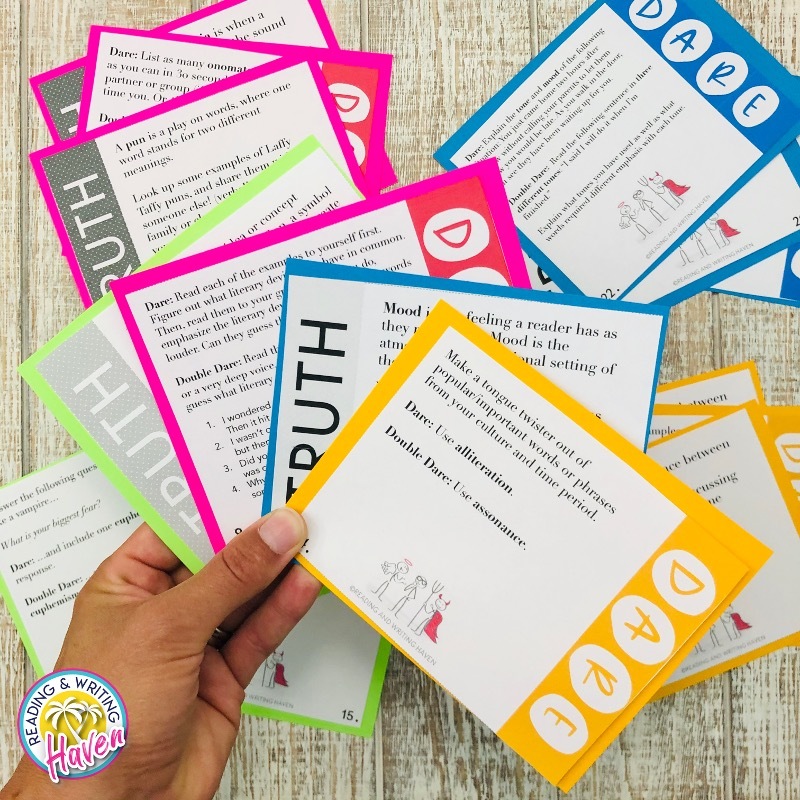
8. Re-Read with Color
This reading strategy is fun, and it can be used with any text. It’s one I came up with as I was brainstorming ways to pull the main idea from a text and then get students to see how that idea is developed by smaller details.
Next time you want students to process important information from a poem, try asking them to re-read with color . Basically, students will pull out the central idea, then text evidence, and finally connect the poem to life. You can give students different prompts as well.
Each time they read through the poem, they look closely at another layer of meaning.
9. Write First
I’m often surprised at how much more willing my students are to participate when I’ve given them an opportunity to process their thoughts in writing before a class discussion. If you are seeking higher engagement, try giving students some time to reflect on questions before engaging with peers.
These poetry journal prompts each focus on a different important concept and can be used with any poem. Try using them after a class discussion as a way for students to synthesize their opinions.
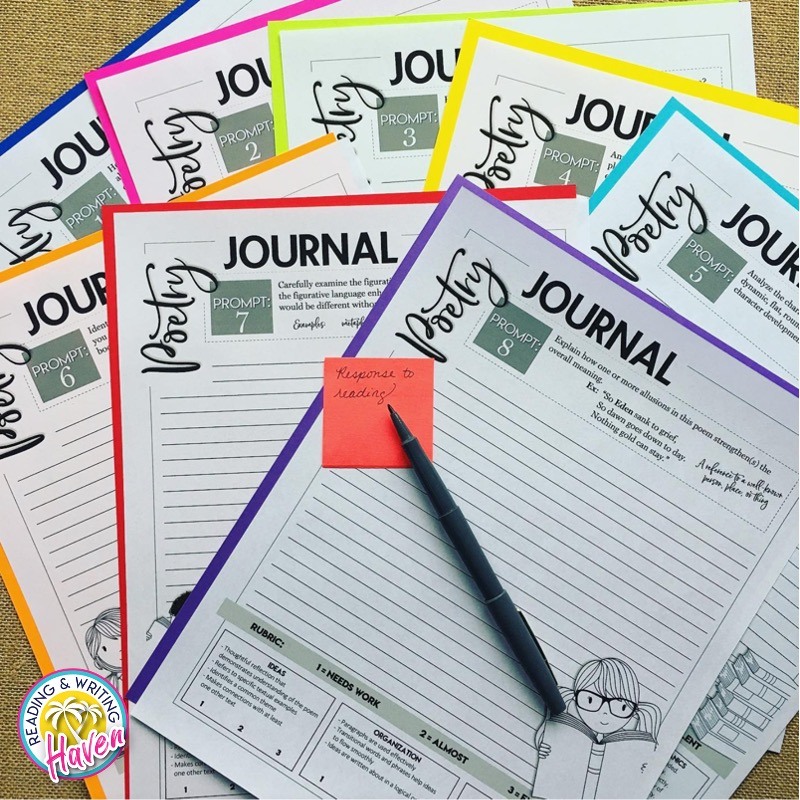
Poetry lessons can be fun. Spice up your next poetry unit with some of these activities, and drop your own favorite approaches in the comments.
RELATED RESOURCE
Grab this creative poetry analysis resource to spice up your existing unit. Use these analytical graphic organizers and written response tools to get your students thinking critically about any song or poem.
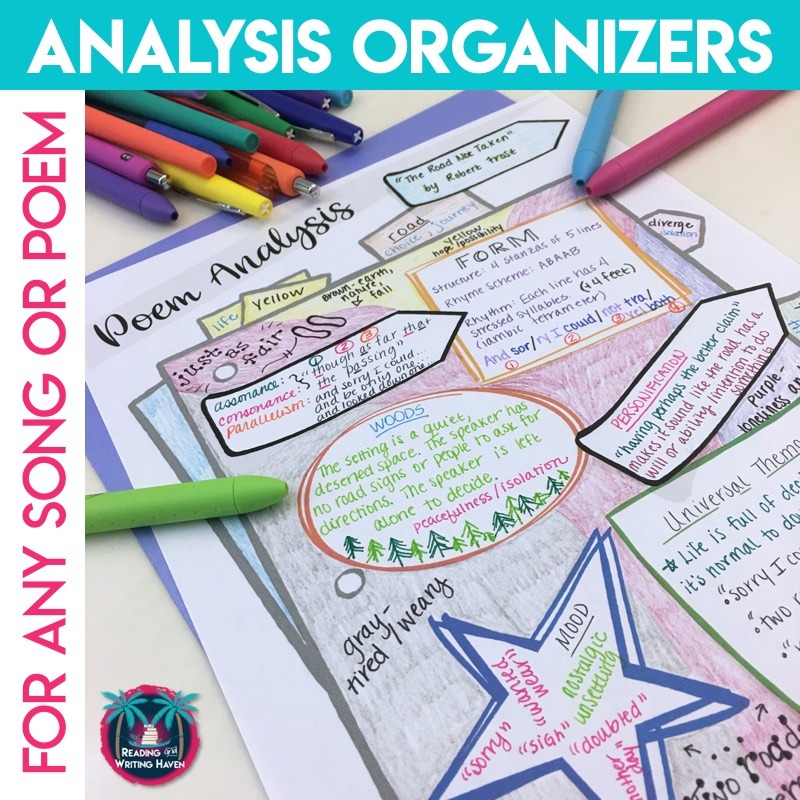
Get the latest in your inbox!
Register for free
POETRY WRITING UNIT: 18 Creative Writing Lessons
$ 9.95 Multi-licenses $ 8.95
- Language Arts
- Resource Type
sold by Brilliantly Lit
View shop page
Item Details
Digital Download
INSTANT DOWNLOAD Files will be available for download from your account once payment is confirmed. Learn more . Please contact the seller about any problems with your order using the question button below the description.
Item description
This creative writing high school POETRY WRITING UNIT has 18 detailed lessons that lead students through fun exercises done in a workbook/journal to complete a poetry portfolio of 7 poems. It is a no prep, print and go (or put on Google Classroom) resource. The 89 slide vibrant PowerPoint presentation with some fun animations lead the students through all of the lessons. A sub without any prep time could supervise these lessons , as all student instructions are supplied in the PowerPoint presentation and the students fill their question responses and drafts directly into their workbook/journal. Everything you need to teach this unit has been done for you. You just need to print out and photocopy the student workbook and you’re set! 18 lessons DONE! Textual analysis tasks are expected of students, but primarily the unit is directed to the writing of poetry of different genres. They are also exposed to some fabulous poems by poets from the United States, the United Kingdom, Australia and Canada. The detailed lesson plans have been designed so that each plan can be directly shared with students on a screen. The lessons are designed to last an hour for an average class. If you have a class that takes their time over activities (either for good or bad reasons!), you might wish to exclude some of the shorter activities. Included with the resource is a 34 page student workbook/journal . I always call this document a journal when speaking about it to my class (it makes them feel more artsy!) but essentially it is a fun workbook. During the unit, students complete short journal entries every class, often several of them. They could receive completion marks for these entries. The workbook is compressed as much as possible to reduce photocopying and is intended for black and white copying. There is enough color in the PowerPoint to please the eye if you take the photocopying route! The students can also decorate their journals themselves. Handouts that you might wish to copy for students (such as a literary terms glossary) are grouped together for convenience at the end of the resource. Only Lesson 1 requires supplies. Scissors, old magazines or books, plain paper and glue sticks are needed for Found Poetry. For the other 17 lessons just the photocopied journal and student creativity are needed. Access to the internet is required to access some of the more recent poems. ALL LESSONS ARE STUDENT TESTED AND APPROVED!
Table of contents Portfolio contents summary Lesson 1 OK, so what is poetry anyway? Lesson 2 Vocabulary selection Lesson 3 Avoiding clichés Lesson 4 Vivid words Lesson 5 Imagery Lesson 6 Line lengths Lesson 7 Literary devices Lesson 8 Literary devices #2 Lesson 9 Rhyme and meter Lesson 10 Narrative poetry Lesson 11 Ballads Lesson 12 Slam poetry #1 Lesson 13 Slam poetry #2 Lesson 14 Slam poetry #3 Lesson 15 Slam poetry #4 performance! Lesson 16 Portfolio compilation time Lesson 17 Peer review time Lesson 18 Poetry celebration
Handouts you might photocopy: Portfolio checklist Literary devices glossary Tips for the verbal reading of poetry Peer feedback form Teacher portfolio rubric
Thanks so much for checking out my resources! Click HERE to go to the FOLLOW button. Followers receive email notification of new products, including freebies.
If you purchase this resource, it would be grand if you could review it afterwards. If you have any questions, comments, or suggestions about this product – or any other product in my store – please write to me at [email protected]. I would love to hear from you!
From the same author
Readers theater scary mystery script grades 5-8: haunted house.
by Brilliantly Lit
This high interest Readers’ Theater brainteaser mystery will give grades 5-8 students practice in reading, comprehension and writing, while having lots of fun. The Mystery of the Haunted House script will entertain…
- Literacy Centers
READING COMPREHENSION MYSTERY PASSAGE: Mystery of the Literary Terms Test
A fun brain teaser mystery comprehension story to get your grades 5-8 students’ brain cells zinging while simultaneously learning 15 literary terms? What a combo! It really doesn’t get much better,…
CREATIVE WRITING FREEBIE FUN
These creative writing quickie activities have stimulated some of the most fun times I have ever had with my high school students! Each takes about 20- 25 minutes to write;…
Aesop’s Fable The Ant and the Grasshopper FREE Readers’ Theater Script
This free readers’ theater The Ant and the Grasshopper 24 roles script will keep your class together for community enhancing Aesop’s fun, rather than splitting off into small groups. Each student has…
BRAIN TEASER MYSTERIES GRADES 9-12: NO PREP COMPREHENSION
Short mysteries are not only fun brain teasers, but also practice listening and inference skills. They are carrots for High School students for the end of the day, or bell…
- Critical Thinking
65 ELA Games GRADES 3-4 no prep INSTANT FUN activities
INSTANT FUN! 65 quick ELA games and activities are crammed into the vibrant pages of this grades 3-4 resource. It is paperless AND non-digital! Sometimes you need a game to…

Interactive Poetry Activities Your Students Will Love
Do you want to make poetry so fun and engaging that your students will ask for more? Here are some simple activities to get you started.
1. Blackout Poetry
There are so many reasons blackout poetry is great: kids love it, it's creative, and it forces you to clean the falling-apart books from your classroom library without the guilt of tossing them in the trash.
What is blackout poetry? It's simple. Rip out the pages of old books. Give the students some basic instructions, then watch the creativity flow!
Sample Instructions:

Blackout Poetry Examples:

2. Poet VS Poet
College basketball's March Madness is the perfect time to pit poet against poet for some exciting classroom debates, but any time of year teachers can create a similar feel by putting poets head to head and comparing their power.
Kids love competition. Creating competition with poetry naturally adds excitement and connects a sometimes intimidating genre with something familiar.

How do you implement a poet vs poet match up in your classroom? You could use an already created tool ( see Poet Vs Poet here ) or create your own match ups. For example, after a simple lesson on figurative language, ask your students to read the poetry of two different poets and rate their use of metaphors, similes, personification, and imagery. As a class, debate the poet's ratings using text based evidence.
If you are at all familiar with the basketball brackets of March Madness, poetry brackets work the same way (and you can find and download blank brackets by doing a simple Google search). I like to start with a sweet sixteen of poets, then narrow down to an elite eight, a final four, a championship, and a winner. Poets advance by having classes vote on the better poet in each match up. The reward of listening to kids debate poet's skills like the poets are athletes is worth any time it takes setting up this activity.
3. Found Poems

Found poems give language to students who may struggle to find the right words. Found poetry is easily accessible, hands on, and fun. Easy to set up, all you need to do to implement found poetry in your classroom is gather together stacks of old magazines, scissors, glue, and colorful paper.
First, instruct students to find powerful words in the pages of magazines, cut them out, and make piles on their desk. You could also assign cutting out powerful words from old magazines for homework and save yourself the time and mess in your classroom.
Next, students arrange and rearrange the words on their desk into meaningful poetry. This is a great opportunity to reinforce the power of form, shape, and line breaks in poetry and encourage students to be thoughtful in their choices. Talk to your students about choosing the best words, eliminating unnecessary words, and playing around with word choice.
Finally, instruct students to glue their poem into place on a colorful piece of paper and decorate your room with the beauty and power of poetry.
4. Poetry Escape Room

A poetry escape room is the most engaging and fun way to introduce or review poetry with your students. Escape rooms by nature are hands on and engaging. Combine the fun of an escape room with poetry and your kids will be hooked. (Check out the poetry escape room I did with my students here.)
Escape rooms, or breakout rooms, are a new trend similar to scavenger hunts. In a poetry escape room, students put together clues based on poems, poets, figurative language, poetry form, rhyme scheme, or any other poetic element. Then, students work to unlock the clues using their poetry knowledge.
Poets are experts at hiding meaning within the lines of their poetry, so use that to create clues that ask students to interpret, make inferences, and analyze. Escape rooms are a great method of turning tasks that can be intimidating to kids and making them into interactive challenges that students are motivated to engage in.
To create a poetry escape room, first choose the poetic elements or reading skills you want to target, a specific poem you want students to read and reread several times in different ways, or a theme or poet to design your escape room around.
Next, gather the materials and tasks that you would normally share with students in a traditional format, but think of creative ways to turn the tasks into clues. For example, if you want students to identify the figurative language in a poem, create task cards that students have to place in the order that those poetic elements appear in the poem. Hide small letters on the task cards so when students place the cards in order, the next clue appears. See the example below:

Get creative and hide clues within poems with bold words, put clues on task cards that students have to place in a certain order based on analysis, or choose clues based on symbolism or inferences that students can find only when they do a close read of the poem.
Although escape rooms require a lot of preparation and thought, the end result is worth the time. Students will be more engaged, thoughtful, and active in reading poetry than you could ever imagine. Escape rooms are a great way to review poetic elements or kick off a new study of poetry when you really want to catch students' attention and get them motivated.
Check out my step by step guide to creating your own escape room here .

5. Poetry Mash Up
Create a poetry mash up by writing poetry forms on slips of paper and placing them in one jar, types of figurative language and placing them in a second jar, and sound elements and placing them in a third jar. Pass the jars around the classroom and have students choose from each one, writing a poem based on what they chose.
For example, a student might choose haiku (poetry form), imagery (figurative language), and onomatopoeia (sound element). That student would then be challenged to write a haiku with imagery and an onomatopoeia. There are endless combinations and kids will have a blast writing, sharing, and seeing what poems are created in your poetry mash up.
Play over and over and model your poetry writing with students as well. Have fun laughing at the ridiculous and enjoy the surprise when students create some really amazing pieces with different combinations of poetic elements.
Making poetry fun and hands on is not only possible, but with a little creativity, it's really easy to implement at any level. Help your students to find the joy in creating magic with only a few words in different shapes and forms. Take the intimidation factor out of poetry by connecting poetry to fun challenges, familiar activities, and hand on learning.

- Poetry Lesson Ideas

Recent Posts
Three high impact, low prep lessons for middle school ELA
Implementing Poetry March Madness
Integrating Poetry All Year Round
- Skip to primary navigation
- Skip to main content
- Skip to footer
KidsKonnect
Reading Comprehension Cause and Effect Context Clues Compare and Contrast
Noun Worksheets Writing Prompts Compound Words Figurative Language
The Wizard of Oz Hans Christian Andersen Types of Writing Text Structure
Literary Devices
Alliteration Hyperbole Metaphor Irony
Subject Verb Agreement Poetry Climax Rhyme
View all reading worksheets
Action Verbs Tragedy Transition Words Phonics
View all writing worksheets
Dramatic Irony Cacophony Anaphora Setting
View all literature worksheets
Abbreviations Transition Words Conclusion Situational Irony
View all literary device worksheets
Women’s History
Inspirational Women Women's History Month First Lady of the US Women's Equality Day International Women's Day
View all Women's History worksheets
American Revolution
American Revolution Patriots & Loyalists Patrick Henry Sons of Liberty
View all American Revolution worksheets
US Constitution US Independence Trail of Tears The Pilgrims
View all US History worksheets
Ancient History
Ancient China Ancient Mayan Ancient Rome Ancient Aztec
View all Ancient History worksheets
World History
Roaring Twenties Industrial Revolution Middle Ages The Renaissance
View all World History worksheets
Famous Wars
World War 1 World War 2 Vietnam War American Civil War
View all Famous War worksheets
Anne Frank Sally Ride Neil Armstrong Christopher Columbus
View all famous figure worksheets
Joe Biden Donald Trump Abraham Lincoln George Washington
View all President worksheets
Roald Dahl Dr Seuss JK Rowling Michael Morpurgo
View all author worksheets
Civil Rights
Rosa Parks Sojourner Truth Medger Evers Martin Luther King
Elvis Presley Johann Sebastian Bach Ella Fitzgerald Wolfgang Mozart
View all musician worksheets
Thomas Edison Albert Einstein Henry Ford Wright Brothers
View all inventor worksheets
Muhammad Ali Michael Jordan Jackie Robinson Jesse Owens
View all athlete worksheets
Nat Turner Ruby Bridges Harriet Tubman Booker T Washington Malcolm X
View all civil rights worksheets
Natural Wonders
River Nile Mount Everest Sahara Desert Mount Etna Ancient Pyramids Amazon River
Landmarks/Sights
Mount Rushmore Statue Of Liberty White House Stonehenge Great Wall of China Santa Fe Trail
New York Texas South Carolina Alaska Nevada Ohio
Australia United Kingdom China Canada Argentina Brazil
Mount Fuji Mississippi River Rocky Mountains Volcano Glacier The Great Barrier Reef
View all natural wonders worksheets
Hoover Dam Bermuda Triangle Leaning Tower Of Pisa Arc De Triomphe Golden Gate Bridge Colosseum
View all landmark worksheets
California Colorado Indiana Florida Washington Georgia
View all US state worksheets
Poland Greece Philippines Japan France India
View all country worksheets
June Topics
Juneteenth D Day Flag Day Father’s Day Shavuot Summer Solstice Eid al-Adha Marshall Plan Summer Northern Hemisphere
View all Seasonal worksheets
Social Emotional Learning
Morals and Values Self Management Ethics Depression Relationship Skills Self-Awareneess Self-Esteem Emotions and Feelings Goal-Setting Interpersonal Skills
View all Social-Emotional Learning worksheets
Celebrations
Easter Saint Patrick’s Day Valentines Day Chinese New Year Rosh Hashanah Thanksgiving Flag Day Cinco de Mayo Beginning Of Lent Yom Kippur View all Celebrations worksheets
Remembrance
Pearl Harbor Day Veterans’ Day Memorial Day Battle Of The Somme D-Day 9/11 Anzac Day Martin Luther King Jr. Day International Women’s Day Victoria Day View all Remembrance worksheets
Camels Fox Bears Penguin Wolf Beavers Mountain Lion Red Panda Snow Leopard White Tigers Silverback Gorilla Okapi
View all mammal worksheets
Marine Life
Crabs Starfish Fish Octopus Great White Shark Dolphin Walrus Narwhal Megalodon Shark Killer Whale Beluga Whale Lionfish
View all marine life worksheets
Insects/Invertebrates/Reptiles
Millipede Praying Mantis Ladybug Ants Spider Iguana Chameleon Komodo Dragon Lizard Bearded Dragon Gila Monster Snakes
View all insect worksheets
Eagle Peregrine Falcon Snowy Owl Emu Woodpecker Albatross Swan Quail Bald Eagle Hummingbird Peacock
View all Bird worksheets
Natural World
Avalanche Flood Tsunami Natural Disasters Fossils Ice Age
View all natural world worksheets
Earth Sciences
Water Cycle Global Warming Deciduous Forests Hurricane Sandy Hurricane Katrina Global Warming
View all earth science worksheets
Food Chain Fossils Photosynthesis Cells Ecosystem Plants
View all biology worksheets
Solar System Black Holes Eclipse Stars and Constellations The Moon Comets
View all space worksheets
Chemistry/Physics
Magnetism Graduated Cylinders Solid, Liquid, Gas Gravity Light Sound
View all science worksheets
Kangaroo Horse Bear Lion Lizard Octopus
View all animal worksheets
Addition Sentences Single Digital Addition Two-Digit Addition Three Digit Addition Repeated Addition
View all Addition Worksheets
Ordinal Numbers Cardinal Numbers Rounding Numbers Odd & Even Numbers Comparing Numbers
View all Numbers Worksheets
Counting Money Subtracting Money Change Money Coin Name & Value Calculate Change (Money)
View all Money Worksheets
Number Line Single Digit Subtraction Place Value Subtraction Sentences Input & Output Tables
View all Math Worksheets
9 totally unique poetry activities for high school students
Search for worksheets.

Studying poetry with high schoolers can be really fun. There are so many different forms of poetry — yes, including pop songs! — and writing poems is an incredible creative outlet for teenagers.
Here’s a rundown of fun poetry games and activities, which can work for standalone high school lessons or as warm-ups to a writing assignment.
Pop Sonnets
If you’re teaching a unit on Shakespeare, this activity will be an absolute hit with your students.
Assign them a sonnet written by the Bard, and ask them to transform it into a modern pop song. It’ll get them thinking hard about the language and writing style he uses. Once they’re comfortable with it, they could even Shakespear-ize their favorite pop hits.
There’s a blog with loads of examples if you want to go through the process with your students. Remember, much of Shakespeare’s work is written in iambic pentameter — perhaps use these worksheets to introduce your students to this concept, before moving onto the pop sonnets.
Poetry journal
Freewriting is a fantastic way to free up headspace and get the creative juices flowing. Give high schoolers a small notebook to serve as their poetry journal — a book that’s only for them, which you will never look at.
Without fear of criticism or judgment, they’ll be much more likely to find their voice. You can give them poetry journal prompts and let their imagination run wild. Allocate a 15-minute ‘free writing’ block before or after your lesson, and see how they develop!
Slam poetry
Sometimes kids might see poetry as lame or outdated, so it’s up to you to show them all the exciting modern forms that poetry can take.
Slam poetry might be one of the best for self-expression: there are no rules or formats for slam poets to follow. It has an element of performance and theatrics and is a way to share a personal story they might otherwise be uncomfortable talking about.
Watch some slam performances on YouTube, then ask students to write their own. Some of the best examples use language techniques like alliteration, rhyme, repetition, anaphora, or similes to help give the story depth. Check out our library of worksheets on various literary devices if you or your students need a refresher.
Blackout poetry
This activity is a classic and a great way to get creativity flowing before a class.
Give your students photocopied pages of a book or textbook, and ask them to find a poem within the words already printed on the page. They blackout the rest of the words with markers, leaving only their “poem” visible. Get students to first read the page, making note of any words that stand out or speak to a theme they’re interested in. Then they can start blacking out words.
And, FYI, the New York Times has an online blackout poetry tool if you can’t access old books or a photocopier.
Analyzing songs
Literary analysis can be much more enjoyable if the student actually likes the text to begin with. So don’t forget that most modern songs are a form of poetry.
Songs by artists like Adele, Taylor Swift, and Eminem (he has a few clean, age-appropriate songs!) are full of metaphors and clever writing. Ask them to read through the lyrics and identify language techniques and poetic devices. It’s a great way for students to see these techniques in practice, before writing their own. This figurative language worksheet bundle has an extensive list of literary devices to keep an eye out for.
Texting couplets
Once again, this activity takes something teenagers are comfortable with and turns it into a poetry medium. Instead of taking out their notebooks, ask students to get into pairs and use their phones to make a poem together. (If you’re homeschooling, you can do it one-on-one with your student.)
Ask them to send poetic couplets back and forth, and to make it sound like a conversation. Before they start, choose a specific technique you’d like them to highlight in their work — a theme, a grammar concept like alliteration, or Shakespearean metaphors.
Picture-inspired poetry
Some days, it might be hard for students to get motivated or inspired. But creative springboards are a good way to get around writers’ block.
Gather a collection of pictures — from magazines, old photo archives, or famous paintings — and ask them to select one and write a poem about it. Take it a step further and find a kids’ picture book. Cover up the words and photocopy the pages, then ask your students to write a long poem or multiple couplets to tell the story they see in front of them.
Warm-up games
Some rhyming games may feel a little childish for high school students, but it’s a good way to get their minds sharp and switched-on before a lesson. We’ve got rhyming worksheets for younger students , with games you can adapt to a high school class. Sit in a circle and choose a word — everyone must take turns coming up with a rhyme but if they repeat a word or take too long, the game is over. It’s just a fun little way to start off the class.
Micro-poems
Your students probably know that tweets are limited to 240 characters — which is not a lot! But why not impose this limit on their poems, and get them to create some micro-poetry.
They’ll have to get really creative with their language in order to convey the right tone in less than 240 characters. They can check out the hashtags #micropoetry and #poetweet for inspiration.
Remember that poetry isn’t something that comes easy to everyone. You may encounter some stumbling blocks when teaching it to high school students, but hopefully these poetry activities will make it seem less like a chore and more like a fun way to express themselves.
Sign up to be notified when we release new articles and worksheets!
You have successfully joined our subscriber list.
Related Articles

Link/cite this page
If you reference any of the content on this page on your own website, please use the code below to cite this page as the original source.
Link will appear as 9 totally unique poetry activities for high school students: https://kidskonnect.com - KidsKonnect, June 7, 2020
KidsKonnect is a growing library of high-quality, printable worksheets for teachers and homeschoolers.
Home Facts Privacy About Blog Contact Terms
Safe & Secure
We pride ourselves on being a safe website for both teachers and students. KidsKonnect uses a secure SSL connection to encrypt your data and we only work with trusted payment processors Stripe and PayPal.
The Power Of Poetry: A Beginner’s Guide To Writing Poetry
- The Power Of Poetry
- Additional Resources
Interest in poetry has been on the rise lately. Among students and children, surveys suggest that today around a quarter of them read poetry recreationally and around a fifth write poetry recreationally , which is a significant increase compared to the last decade. Similar significant increases in interest in poetry have been seen among adults, especially young adults .
Since the interest is clearly there , it would make sense to incorporate poetry into a curriculum and to use it to increase student’s engagement with learning. To help, we will explain some of the powerful benefits of teaching poetry as well as provide activities and resources that will assist in teaching poetry to students and children.
The power of poetry
Poetry can be a powerful tool in the classroom. Research and scientific studies have shown that students who engage with poetry as part of their learning demonstrate higher reading skills, creative writing skills, and enthusiasm for literature . Poetry also gives students the opportunity to increase their vocabulary and oral communication skills. Poetry also often allows students to gain higher cultural awareness by being introduced to views, experiences, and societies beyond their own. In addition to all of that, reading poetry has been shown to be good for a person’s mental health and can help students learn empathy and compassion for others .
So, it should go without saying that there are lots of benefits to teaching students poetry. But are there methods to present poetry to students in a way that even those who find poetry intimidating or uninteresting will find engaging?
Poetry activities
To help increase interest in learning poetry, many teachers find it helpful to introduce students to it using different activities. Listed below are just some ideas of activities that may help students find poetry more appealing or exciting.
- Have students read their favorite poem aloud. Ask them to explain why they like it and why they feel a connection to it.
- Create a poem by having each student contribute a line.
- Introduce a new type of poem (acrostic, limerick, haiku, etc.) to students each week and hold a weekly challenge where students write a different style of poem.
- Have students memorize a poem and recite it back.
- Have students write poetry about their favorite thing from popular culture or from the perspective of a favorite fictional character.
- Ask students to find a song they like and see if they can find what poetic techniques the artist used, such as rhyme scheme, metaphor, or personification, for example.
- Build “pop sonnets” by challenging students to transform a modern song into a specific type of poem or to transform a classic poem into a modern pop song.
- Challenge students to make a poem using a weird word list or words that don’t seem to go well together.
Make Your Writing Shine!
- By clicking "Sign Up", you are accepting Dictionary.com Terms & Conditions and Privacy policies.
- Comments This field is for validation purposes and should be left unchanged.
Additional Dictionary.com and Thesaurus.com poetry and writing resources
Writing poetry is an exciting way to build vocabulary. And we provide much more than vocabulary resources that can inspire novice and advanced poets alike. Browse our writing guides related to poetry for more ideas.
▶ More Poetry Activities For Kids
In honor of World Poetry Day, we’ve crafted this collection of surefire ways to instill appreciation and excitement for the vast world of poetry.
▶ Learn How To Write a Haiku
Here’s what you need to know to write a traditional or modern haiku. Learn the history of this Japanese form and read a variety of examples from the masters.
▶ Poetic Foot vs. Poetic Meter
Poetry has a lot of moving parts, and a great place to start is by understanding rhythm and sequence. Learn the difference between a poetic foot and meter.
▶ Are There Any Words Without a Rhyme?
It’s the age-old question… or at least the age-old word game question: are there any words without rhymes?
▶ Poetry Terms For Beginners
There’s no better time than now to learn how to talk about the poetry you love. Here are 10 basic terms explained so you’ll be poetry-ready all year long.
▶ Poetry Terms For Advanced Poets
Impress your teachers and friends with your knowledge of these advanced poetic terms that will help you read and understand poetry like an expert.
▶ 12 Essential Types of Poetry
There are many different kinds of poetry out there. Learn more about 12 essential types of poetry to expand your poetry knowledge.
▶ Positive Words Starting With A to Z
Seeing the good in life can be tough. Luckily, we have a long list of positive words to help you out—amazing ones and zippy ones and everything in between.
▶ Negative Words Starting With A to Z
Life got you down? We can’t always make it better, but we can offer creative ways to express your worldly woes with this A-to-Z list of negative words.
▶ Writing Prompts
Whether you are trying to defeat writer’s block, practice writing, or increase your creativity, writing prompts are a great tool to incorporate into your writing routine.
▶ 14 Types of Wordplay
Wordplay is no joke! It’s what makes language so lively, after all. Whip your words into a frenzy with these entertaining types of wordplay.
▶ 12 Steps to Improve Your Writing Skills
Writing a paragraph? An essay? Maybe a novel? Regardless of your project, here are 12 things you can do right away to improve your writing.
▶ Writing Activities For Elementary School Students
Looking for ways to get your elementary student to write more? We’ve compiled activities within 6 themes including poetry, weather, and space.
▶ Writing Activities for Middle School Students
These writing activities for middle schoolers can help them improve their skills and channel creativity. Try out a writing activity yourself, too!
Check out our hub for all you need to learn and teach the essentials of English grammar.

Ways To Say
Synonym of the day
Jump to navigation Skip to content
Search form
- P&W on Facebook
- P&W on Twitter
- P&W on Instagram
Find details about every creative writing competition—including poetry contests, short story competitions, essay contests, awards for novels, grants for translators, and more—that we’ve published in the Grants & Awards section of Poets & Writers Magazine during the past year. We carefully review the practices and policies of each contest before including it in the Writing Contests database, the most trusted resource for legitimate writing contests available anywhere.
Find a home for your poems, stories, essays, and reviews by researching the publications vetted by our editorial staff. In the Literary Magazines database you’ll find editorial policies, submission guidelines, contact information—everything you need to know before submitting your work to the publications that share your vision for your work.
Whether you’re pursuing the publication of your first book or your fifth, use the Small Presses database to research potential publishers, including submission guidelines, tips from the editors, contact information, and more.
Research more than one hundred agents who represent poets, fiction writers, and creative nonfiction writers, plus details about the kinds of books they’re interested in representing, their clients, and the best way to contact them.
Every week a new publishing professional shares advice, anecdotes, insights, and new ways of thinking about writing and the business of books.
Find publishers ready to read your work now with our Open Reading Periods page, a continually updated resource listing all the literary magazines and small presses currently open for submissions.
Since our founding in 1970, Poets & Writers has served as an information clearinghouse of all matters related to writing. While the range of inquiries has been broad, common themes have emerged over time. Our Top Topics for Writers addresses the most popular and pressing issues, including literary agents, copyright, MFA programs, and self-publishing.
Our series of subject-based handbooks (PDF format; $4.99 each) provide information and advice from authors, literary agents, editors, and publishers. Now available: The Poets & Writers Guide to Publicity and Promotion, The Poets & Writers Guide to the Book Deal, The Poets & Writers Guide to Literary Agents, The Poets & Writers Guide to MFA Programs, and The Poets & Writers Guide to Writing Contests.
Find a home for your work by consulting our searchable databases of writing contests, literary magazines, small presses, literary agents, and more.

Poets & Writers lists readings, workshops, and other literary events held in cities across the country. Whether you are an author on book tour or the curator of a reading series, the Literary Events Calendar can help you find your audience.
Get the Word Out is a new publicity incubator for debut fiction writers and poets.
Research newspapers, magazines, websites, and other publications that consistently publish book reviews using the Review Outlets database, which includes information about publishing schedules, submission guidelines, fees, and more.
Well over ten thousand poets and writers maintain listings in this essential resource for writers interested in connecting with their peers, as well as editors, agents, and reading series coordinators looking for authors. Apply today to join the growing community of writers who stay in touch and informed using the Poets & Writers Directory.
Let the world know about your work by posting your events on our literary events calendar, apply to be included in our directory of writers, and more.

Find a writers group to join or create your own with Poets & Writers Groups. Everything you need to connect, communicate, and collaborate with other poets and writers—all in one place.
Find information about more than two hundred full- and low-residency programs in creative writing in our MFA Programs database, which includes details about deadlines, funding, class size, core faculty, and more. Also included is information about more than fifty MA and PhD programs.
Whether you are looking to meet up with fellow writers, agents, and editors, or trying to find the perfect environment to fuel your writing practice, the Conferences & Residencies is the essential resource for information about well over three hundred writing conferences, writers residencies, and literary festivals around the world.
Discover historical sites, independent bookstores, literary archives, writing centers, and writers spaces in cities across the country using the Literary Places database—the best starting point for any literary journey, whether it’s for research or inspiration.
Search for jobs in education, publishing, the arts, and more within our free, frequently updated job listings for writers and poets.
Establish new connections and enjoy the company of your peers using our searchable databases of MFA programs and writers retreats, apply to be included in our directory of writers, and more.

- Register for Classes
Each year the Readings & Workshops program provides support to hundreds of writers participating in literary readings and conducting writing workshops. Learn more about this program, our special events, projects, and supporters, and how to contact us.
The Maureen Egen Writers Exchange Award introduces emerging writers to the New York City literary community, providing them with a network for professional advancement.
Find information about how Poets & Writers provides support to hundreds of writers participating in literary readings and conducting writing workshops.

Bring the literary world to your door—at half the newsstand price. Available in print and digital editions, Poets & Writers Magazine is a must-have for writers who are serious about their craft.
View the contents and read select essays, articles, interviews, and profiles from the current issue of the award-winning Poets & Writers Magazine .
Read essays, articles, interviews, profiles, and other select content from Poets & Writers Magazine as well as Online Exclusives.
View the covers and contents of every issue of Poets & Writers Magazine , from the current edition all the way back to the first black-and-white issue in 1987.
Every day the editors of Poets & Writers Magazine scan the headlines—publishing reports, literary dispatches, academic announcements, and more—for all the news that creative writers need to know.
In our weekly series of craft essays, some of the best and brightest minds in contemporary literature explore their craft in compact form, articulating their thoughts about creative obsessions and curiosities in a working notebook of lessons about the art of writing.
The Time Is Now offers weekly writing prompts in poetry, fiction, and creative nonfiction to help you stay committed to your writing practice throughout the year. Sign up to get The Time Is Now, as well as a weekly book recommendation for guidance and inspiration, delivered to your inbox.
Every week a new author shares books, art, music, writing prompts, films—anything and everything—that has inspired and shaped the creative process.
Listen to original audio recordings of authors featured in Poets & Writers Magazine . Browse the archive of more than 400 author readings.
Ads in Poets & Writers Magazine and on pw.org are the best ways to reach a readership of serious poets and literary prose writers. Our audience trusts our editorial content and looks to it, and to relevant advertising, for information and guidance.
Start, renew, or give a subscription to Poets & Writers Magazine ; change your address; check your account; pay your bill; report a missed issue; contact us.
Peruse paid listings of writing contests, conferences, workshops, editing services, calls for submissions, and more.
Poets & Writers is pleased to provide free subscriptions to Poets & Writers Magazine to award-winning young writers and to high school creative writing teachers for use in their classrooms.
Read select articles from the award-winning magazine and consult the most comprehensive listing of literary grants and awards, deadlines, and prizewinners available in print.

- Subscribe Now
Writing Prompts & Exercises
The time is now.
The Time Is Now offers three new and original writing prompts each week to help you stay committed to your writing practice throughout the year. We also curate a list of essential books on writing —both the newly published and the classics—that we recommend for guidance and inspiration. Whether you’re struggling with writer’s block, looking for a fresh topic, or just starting to write, our archive of writing prompts has what you need. Need a starter pack? Check out our Writing Prompts for Beginners.
Tuesdays: Poetry prompts Wednesdays: Fiction prompts Thursdays: Creative nonfiction prompts
Get immediate access to more than 2,000 writing prompts with the tool below:
Attentiveness
- Printable Version
- Log in to Send
- Log in to Save

Nearly fifty years ago, the writer George Perec spent three days sitting behind a café window in Place Saint-Sulpice in Paris recording everything he saw. In his short book, An Attempt at Exhausting a Place in Paris , his observations of mundane occurrences and objects often considered unnoteworthy—passersby, cars, buses, pigeons, signs, and slogans—are documented. This week situate yourself in one spot, perhaps in your home or workplace, or in a public space like a park, busy crossroad, commercial area, library, or café. Then, jot down the objects and behavior you see, and the snippets of conversation you hear. Write a lyric essay composed of these notes, trying to avoid interpretations or analysis. Taken together, how do your observations create a portrayal of a specific time or place? Pay particular attention to how one observation might lead to another, and to potential rhythms and repetitions.
Power Couple
The 2023 thriller film Fair Play , written and directed by Chloe Domont, follows the lives of a young, newly engaged couple, Luke and Emily, who are colleagues working as analysts in the cutthroat world of high finance in New York. The film focuses on the progression of their relationship, which has been kept hidden from their hedge fund office, and the bitter disintegration of their happiness after a promotion that was initially rumored to go to Luke is unexpectedly bestowed upon Emily, which situates him as a subordinate to his wife within a misogynistic workplace. Write a short story that revolves around an occurrence that catalyzes a shift in the power dynamic between two main characters who have a close relationship. What are the initial responses, and does the transformation happen suddenly or gradually? Are there gender, generational, or other cultural issues that play a role?
Organic Insinuations
“All too often, on a ‘poetry scene,’ people prioritise ‘subject matter,’” says John Burnside in a 2023 interview about his writing process by Jesse Nathan published on McSweeney’s Internet Tendency. “I am sure that, as I am working, environmental concerns insinuate their way into the content of a poem organically, as other concerns will—but I would never start from there.” Inspired by the late Scottish poet, who died at the age of sixty-nine on May 29, write a poem that springs not from a predetermined topic or subject matter, but instead allows you to “trust in the sounds, the rhythms that come out of the day-to-day, the sheer immediacy and truth of the quotidian…and the images that lead, sometimes via fairly roundabout paths, to metaphor.” Later, as you reread and revise, what do you discover is the subject of your poem? What might have organically insinuated itself into your poem?
The maintenance or restoration of native plant and animal species has long been at the heart of many ecological and conservation projects, and has historically been a focus of land and environmental stewardship principles held by native and first peoples all over the world. But what if a beloved plant or animal is considered invasive, like the palm trees of Los Angeles or the cattle of Texas? What are the effects or consequences of centuries of existence with this invasive species in a particular locale? This week reflect on the notion of belonging—what are various places and times when you have felt a strong sense of belonging, and situations when you did not feel you belonged? Consider your own perspectives and responses when you encounter someone or something else that seems invasive or does not belong.
In Stephen King’s 1983 novel, Pet Sematary , a doctor moves into a remote house in Maine with his wife, two young children, and their pet cat, and learns from a neighbor about an ancient burial ground nearby cursed by a malevolent spirit which gave it power to reanimate those buried there. This is put to the test first by the family cat, and then by members of the family who die throughout the course of King’s horror story. While each formerly dead being is returned to the land of the living, they don’t come back quite the same. Write a story in which a creature or person returns from the dead, either in actuality or under circumstances in which their reappearance feels as if they are “back from the dead.” What familiar traits remain the same and what is disconcertingly different? Is their return ultimately for the better or the worse?
“I told a friend about a spill at the grocery store, which—the words ‘conveyor belt’ vanishing midsentence—took place on a ‘supermarket treadmill,’” writes Madeleine Schwartz in a recent essay published by New York Times Magazine about her experience of negotiating with and toggling between the French and English languages after moving from New York to Paris. In the piece, Schwartz notes that as she became more comfortable with living and thinking in French, she noticed a blurring of her linguistic capabilities, including a muddling of her articulative abilities in English. Think about a time or situation when words have failed you, or you’ve drawn a blank as to the mot juste. Write a poem that traces or enacts a loss of language, perhaps using invented words, phrases, and spellings or experimenting with font sizes, line breaks, and spacing.
Edible Memories
Many foods, flavors, and dishes hold a wellspring of emotional associations because they remind us of loved ones, habits and traditions, specific locales, and a different time of our lives when we were different people. Write a series of flash nonfiction pieces this week with each segment focusing on an edible item that evokes particularly resonant memories for you. You might begin by jotting down lists of foods you ate regularly growing up—breakfasts, school lunches, vending machine go-tos, favorite fast-food joints, diners, late night spots, home-cooked specialties—as well as a few momentous meals. Who are the people you associate with each one? Aside from taste and smell, consider the surrounding environment, atmospheric sounds, time of year, and who you were at that point in your life.
Wheels and Nails
While the American proverb “the squeaky wheel gets the grease” may be one you’ve heard time and again, often in reference to the idea that whoever raises or vocalizes a criticism the loudest will be appeased, there is a Japanese saying that translates to “the nail that sticks out gets hammered down,” which points to the positives of conformity in order to maintain a productive and humble society. It can also refer to putting someone who has become too successful back down in their place. Write a story in which your main character diverges from a group of people, and sticks their neck out, so to speak. Perhaps they vocalize a contrary perspective, protest something they feel is unjust, or simply present themselves in an unconventional manner. What are the consequences? Does your story lean toward one proverbial lesson or the other, or does the conclusion demonstrate more ambiguity?
Night at the Museum
If you could spend a night at any museum, which would you choose, and why? The French publisher Editions Stock has a series of books that begins with this premise—each author selects a museum, arrangements are made for an overnight stay, and a book is written about the experience. In Jakuta Alikavazovic’s Like a Sky Inside , translated from the French by Daniel Levin Becker, she spends a night at the Louvre in Paris, where childhood memories of visits with her father are vividly recalled. “From March 7 to 8, 2020, I spent the night in the Louvre, alone. Alone and at the same time anything but,” writes Alikavazovic. Write a poem that imagines a night at a museum of your choosing, anywhere in the world. What memories will you excavate from this imagined, solitary experience?
Chosen Family
Although the origin of the term is unknown and can be defined in many ways, a chosen family is made up of a group of people who choose to embrace, nurture, and support each other despite conventional understandings of biological or marital relationships. Oftentimes a chosen family is formed to take the place of a biological family, however, in some cases, these relationships are formed to expand a family. Write a personal essay about a relationship you have with a chosen family member. How did you first meet? Was there a particular incident that catalyzed what would become an inextricable bond? Has your commitment to each other been tested in ways big or small? Reflect on past memories and experiences you have had with this special person and how your relationship has evolved over the years.
Kingdom of the Planet
In the 1968 science fiction film Planet of the Apes , which is based on French author Pierre Boulle’s 1963 novel and has spawned several sequels and a recent reboot, a crew of astronauts crash-lands on a planet ruled by apes who have developed an advanced and hierarchical civilization, complete with systems of governance, labor, scientific research, and a military force. In this far-off place, humans have been reduced to mute primitive beings who are subjugated and kept captive as workers for the primates. Write a speculative story that takes place in another universe with a premise revolving around a role reversal. What are the rules and governing structures of the society that you invent? You might decide to approach your narrative with a tone of horror, satire, or comedy to emphasize your perspective on stereotypical assumptions and social expectations.
Another Country
“I love these raw moist dawns with / a thousand birds you hear but can’t / quite see in the mist. / My old alien body is a foreigner / struggling to get into another country. / The loon call makes me shiver. / Back at the cabin I see a book / and am not quite sure what that is.” In these eight lines that comprise Jim Harrison’s poem “Another Country,” which appears in his final collection, Dead Man’s Float (Copper Canyon Press, 2016), the late poet moves between observations about a natural outdoor setting and the speaker’s own bodily presence, arriving in the final two lines at a sentiment that expresses a feeling of defamiliarization at the seemingly mundane sight of a book. This week write a poem that explores the concept of being so absorbed in one environment or circumstance that to behold a different scene is like traveling to a strange and unknown realm.
Self-Healing
A recent study in Scientific Reports journal revealed that, for possibly the first time, a nonhuman wild animal was seen using plant medicine to heal an active wound. In a rainforest in Indonesia, a Sumatran orangutan was observed ripping off leaves from a climbing vine plant, chewing them, and applying the plant sap to treat a wound on his face, which then healed after a few days. Write a personal essay on the theme of self-healing. Think about experiences when you’ve witnessed another person perform this task, or particularly resonant memories that pertain to your own past behavior. What are the primary emotions present throughout this process? What instances of self-treatment or self-medication in film, art, or literature created an impression on you?
Campus Story
Take inspiration from the concept of a campus novel—which takes place in and around the campus of a university and often involves the intertwined dynamics of students, professors, and conventions about learning and power—and write a story that engages with a school setting, whether prominently situated in the context of the plot or used for a particular scene. Some recent additions to the campus novel canon include Elif Batuman’s The Idiot (Penguin Press, 2017), Xochitl Gonzalez’s Anita de Monte Laughs Last (Flatiron Books, 2024), Kiley Reid’s Come and Get It (G. P. Putnam’s Sons, 2024), and Brandon Taylor’s Real Life (Riverhead Books, 2020). Will you include a character who is a student, teacher, administrative staff member, custodial worker or caretaker, or possibly an alumni revisiting the past? Consider the multitude of ways the incorporation of an educational environment might permeate the atmosphere of the narrative.
The Last Friend
“The day the last friend / dies / we sit alone. / A visitor / from outer space / tries hard / to summon us. / Someone says / EAT DEATH. / I fish around for answers / but the questions / still won’t come,” writes Jerome Rothenberg, who passed away in April, in his poem “The Last Friend.” Included in his collection of one hundred poems, A Book of Witness: Spells & Gris-Gris (New Directions, 2022), the poem presents a list of statements and observations, many of which refer to death or dying in some personal way, though the connections are enigmatic and the logical progression is oblique. Try your hand at writing a poem that mentions its subject directly, but which also deliberately obfuscates or remains ambiguous in its intentions. How might using the “I” as a witness include the reader into your point of view?
Mind Your Manners
The New York City culture and news website Gothamist recently asked New Yorkers about their thoughts on sidewalk etiquette in the crowded, bustling streets of their beloved city. What are the rules, who has the right-of-way, and who should yield? Respondents focused on always walking to the right of the sidewalk and to “move quickly and never stop.” One thoughtful respondent considered the cultural differences of sidewalks used for recreational strolls versus commuting. But the overall consensus was that among nine-to-fivers, tourists, parents with kids, dogwalkers, bicyclists, and groups, seniors deserve the right-of-way. Write an essay about the unwritten rules or etiquette you have observed in your daily surroundings. How have these common practices adapted to fit the needs of different people? Do they evolve over time as social norms change? Consider some of your own experiences with how public etiquette has helped or hindered harmonious community life.
The term sub rosa means “under the rose” in Latin and refers to something said or done in private. The rose has been associated with secrecy since ancient times, a decorative symbol often carved and painted in places like meeting rooms, banquet halls, and confessionals as reminders of confidentiality. This week write a short story that revolves around a conversation or discussion that occurs sub rosa in an enclosed space. Does a certain detail get leaked out or overheard? How might the secretive nature place a burden on your characters? Consider the ways in which the atmosphere and tone of your story feel distinctive in the time and space of your sub-rosa conversation versus the scenes that take place before or after the talk.
Wisdom in Translation
In the anthology Another Room to Live In: 15 Contemporary Arab Poets (Litmus Press, 2024) edited by Omar Berrada and Sarah Riggs, multinational and multilingual poet-translators challenge foundational narratives and rework mythologies through poetic expression. Yasmine Seale’s poem “Conventional Wisdom (Arabic Saying Translated Twenty Ways)” is composed of translations of an ancient aphorism expressing the inextricable place of poetry within Arab cultural heritage. Each line presents a variation on the truism: “Poetry is the record of the Arabs / The art of poetry is Arabs, collected / Good poetry is a list of Arabs / To speak in verse is to remain in Arab memory / To surpass another poet is the Arab odyssey.” Write a poem inspired by this idea of translating a proverb or maxim—either from another language or from English into English. How might you creatively interpolate different “translations” of the saying by incorporating connotations and riffing on free associations and personal experiences?
In Response
In a recent interview with Aria Aber for the Yale Review , when asked his thoughts on the responsibility of the poet, Jackson Prize–winning poet Fady Joudah says, “I often think that the responsibility of the poet is to strive to become the memory that people may possess in the future about what it means to be human: an ever-changing constant. In poetry, the range of metaphors and topics is limited, predictable, but the styles are innumerable. Think how we read poetry from centuries ago and are no longer bothered by its outdated diction. All that remains of old poetry is the music of what it means to be human.” Write a creative nonfiction piece that presents your personal theory of the responsibility of a writer or an artist. To construct an expansive approach, you might use observations about how different creative disciplines overlap in their goals, or consider what has remained resonant as the arts make their mark throughout various eras.
Earth to You
In honor of Earth Week, write a scene that revolves around a character who experiences an unexpected moment in a natural environment that produces a sensation of wonder, perhaps an unusual encounter with wild flora or fauna. You might contrast the elements of this scene with others in your story in which the character is interacting solely with humans or only attuned to the sounds, rhythms, and sights of city life and densely packed civilization. Is the occurrence mind-bogglingly quick and then reflected upon in hindsight, or does time slow down in the scene? How do you manage or manipulate the pacing and rhythm of your prose to draw attention to the emotional and psychological response of the character?
From Dirt Level
In Sharon Olds’s poem “May 1968,” the speaker recounts the memory of spending the night with other protesting students, who lay down their bodies on a New York City street at a university’s campus gates in order to obstruct the mounted police force that had been called in. While “spine-down on the cobbles,” she observes the city and surrounding scenery—the soaring buildings and the police and horses’ bodies—as she gazes upward, thinking about the state of her pregnant body. Write a poem this week from the vantage point of lying face-up, “from dirt level.” What circumstances bring you into this position? How does this upward point of view transform what you see, and how you feel about your own body?
More, please? Or, no more, please? In The Fast: The History, Science, Philosophy, and Promise of Doing Without (Avid Reader Press, 2024), John Oakes recounts his personal experience conducting a weeklong fast and examines the practice’s history and place within a wide range of religions and philosophies. The book also explores the act of self-deprivation and the potential transformative benefits of subtracting rather than adding to one’s life. “The act of fasting…won’t stop routine, but impedes it for a bit, signifying a shift and a determined unwillingness to follow standard operating procedure,” writes Oakes. Use this idea to consider your personal relationship with consumption—of food, conversation, media, clothes, space—and write a personal essay that reflects on what you might otherwise take for granted.
All in Your Head
In “Table for One,” a short story from Korean author Yun Ko-eun’s new collection of the same name, translated by Lizzie Buehler and published by Columbia University Press in April, a surreal quality seeps into the tale of a lonely office worker who enrolls in a course to make solitary dining easier. Tips from the course include: “Target corner tables rather than those in the middle. Seats at the bar are also good. Hang your coat or bag on the chair facing you and take advantage of tools like a book, earphones, a cell phone, or a newspaper.” The fantastic element of the story lies less in the oddity of the premise than in the narrator’s meticulously recounted neuroses and detailed rendering of processes that become seemingly cyclical. Write a scene that focuses on your character’s minute observations as they attempt to overcome something debilitating. Does the situation lend itself to a quirky or dark sense of humor?
Neither Questions nor Answers
“Where is the homeland / to lay a cradle for the dead / Where is the other shore / for poetry to step across the end point / Where is the peace / that lets the days distribute blue sky...” In Sidetracks , forthcoming in May from New Directions, the Chinese poet Bei Dao begins his book-length poem with a list of twenty-five enigmatic questions that dance around mythological, philosophical, and existential subjects. In Jeffrey Yang’s translation, the speaker’s questions lack the end punctuation of the original text, with question marks omitted. Through these unanswered questions, the poet conjures loss and nostalgia. Loosely following this structure, write a prologue to a poem that poses a series of questions gesturing toward your most pressing uncertainties. While Bei Dao’s lines are mysterious and mystical, allow your poem the tone and allusions that feel instinctive to you.
With Certainty
In a 1789 letter, Benjamin Franklin wrote the phrase, “in this world nothing can be said to be certain, except death and taxes.” Franklin was reflecting on the establishment of the U.S. Constitution, which he said promised to be durable, as well as his own ailing health and mortality. This week write a personal essay that riffs off this proverb, reflecting on your own worldview about what can be certain. You might start off with the prompt: “In this world, nothing can be said to be certain, except death, taxes, and ______.” Tell the story of how you arrived at your own ideas about what you can always count on, whether good or bad. What past experiences, encounters, or memories seem to reinforce your belief?
About Our Writing Prompts
What is a writing prompt and how do you use one? Whether you find yourself in front of a blank page or stuck in a work-in-progress, writing prompts can offer a spark that ignites your creative thinking and can lead to new writing. Prompts offer guidance, fresh ideas, and direction for writers of all levels of experience. First, choose a prompt for the genre in which you’d like to write, then carefully read it and consider what it is asking you to think about. It could be a specific setting, a writing technique, or an element of an imagined character; a specific poem, story, essay, song, book, or film from which you might take inspiration; or a current event or a topical theme. A writing prompt is filled with endless possibilities—and there is no wrong way to use one to generate new writing!
What makes our writing prompts unique? We have an archive of over 2,000 prompts, all original and offered here and in our weekly newsletter . You’ll find a variety of poetry, fiction, and creative nonfiction prompts—some inspired by recent and classic literature and other forms of art, current events, and writing practices, and others that offer guidance for a particular form, including sonnets, erasure poetry, flash fiction, lyric essays, and more. For more than fifty years, Poets & Writers has supported creative writers with trustworthy information and inspiration, and our weekly prompts provide a regular dose of encouragement and motivation.
What are the benefits of using writing prompts? Writing prompts can help you get unstuck if you’re in a rut and the ideas aren’t flowing. But even if you’re not experiencing writer’s block, writing prompts can offer a fresh take or a new approach to a work-in-progress. Writing prompts can also provide the motivation to experiment with a new form, try out a new genre, or learn about other writing techniques. And writing prompts are an invaluable tool for teachers who want to encourage and inspire their writing students.
What is this list of Best Books? Best Books for Writers is a list of essential books for creative writers that we curate to support your writing practice. Every week, we add a book (whether new or a classic) with a synopsis and highlights. Included are books on the writing life, anthologies of craft essays, collections of lectures, practical guides with writing exercises, and more.
Poetry writing prompts Every Tuesday we post a new poetry prompt to guide you in your practice. Get to know the work of contemporary and classic poets, as well as a variety of poetic forms.
Fiction writing prompts Every Wednesday we post a new fiction prompt to spark your imagination. Take inspiration from recently published short stories and novels, and of course, the classics.
Creative nonfiction writing prompts Every Thursday we post a new creative nonfiction prompt to help your exploration of this ever-changing genre. These prompts include information and inspiration for a variety of essays as well as memoirs. Discover new writers and their craft, and fresh ways to generate writing inspired by your life.
Need a starter pack? Check out our Writing Prompts for Beginners .
Purdue Online Writing Lab Purdue OWL® College of Liberal Arts
Welcome to the Purdue Online Writing Lab

Welcome to the Purdue OWL
This page is brought to you by the OWL at Purdue University. When printing this page, you must include the entire legal notice.
Copyright ©1995-2018 by The Writing Lab & The OWL at Purdue and Purdue University. All rights reserved. This material may not be published, reproduced, broadcast, rewritten, or redistributed without permission. Use of this site constitutes acceptance of our terms and conditions of fair use.
The Online Writing Lab at Purdue University houses writing resources and instructional material, and we provide these as a free service of the Writing Lab at Purdue. Students, members of the community, and users worldwide will find information to assist with many writing projects. Teachers and trainers may use this material for in-class and out-of-class instruction.
The Purdue On-Campus Writing Lab and Purdue Online Writing Lab assist clients in their development as writers—no matter what their skill level—with on-campus consultations, online participation, and community engagement. The Purdue Writing Lab serves the Purdue, West Lafayette, campus and coordinates with local literacy initiatives. The Purdue OWL offers global support through online reference materials and services.
A Message From the Assistant Director of Content Development
The Purdue OWL® is committed to supporting students, instructors, and writers by offering a wide range of resources that are developed and revised with them in mind. To do this, the OWL team is always exploring possibilties for a better design, allowing accessibility and user experience to guide our process. As the OWL undergoes some changes, we welcome your feedback and suggestions by email at any time.
Please don't hesitate to contact us via our contact page if you have any questions or comments.
All the best,
Social Media
Facebook twitter.
All Formats
Resource types, all resource types.
- Rating Count
- Price (Ascending)
- Price (Descending)
- Most Recent
Free creative writing unit plans
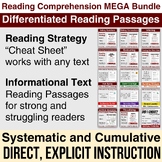
Reading Comprehension Strategies MEGA Bundle | Social Emotional Learning | ELA

Step up to Writing Inspired - Writing a Personal Narrative Unit
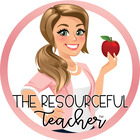
Father's Day Reading Comprehension Compare and Contrast

Writing Units Bundle Narrative Opinion Persuasive Biography Informative

Thanksgiving Writing and Craft! How to Catch a Turkey Free Activity!
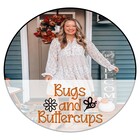
Informative and Explanatory Paragraph Writing Unit Freebie/Sample

Winter Writing and Craft: How to Make Hot Chocolate Sequence Writing

Opinion Paragraph Writing Unit Freebie/Sample
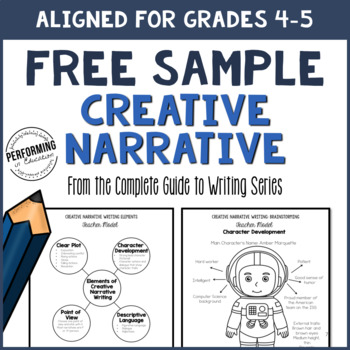
Creative Narrative Writing Sample Grades 4-5 (From the Complete Guide Resource)

Narrative Writing Program Freebie | Fairy Tales Unit of Work
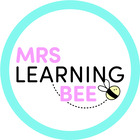
How to Make a Peanut Butter and Jelly: Sequence Writing and Craft Activity

May DIGITAL Would You Rather Writing Prompts for Grades 2-5 for Google Slides

- Google Slides™
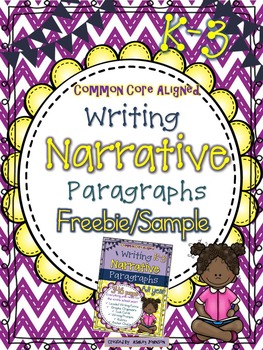
Narrative Paragraph Writing Unit Freebie/Sample
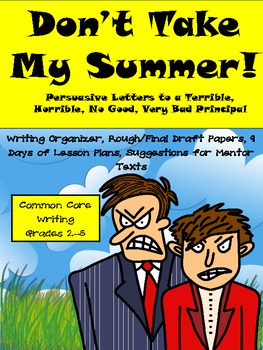
Common Core Summer Vacation Persuasive Writing Pack-9 Day Plans and More!

Personal Narrative Rubric used with Lucy Caulkin's Writing Program

- Word Document File
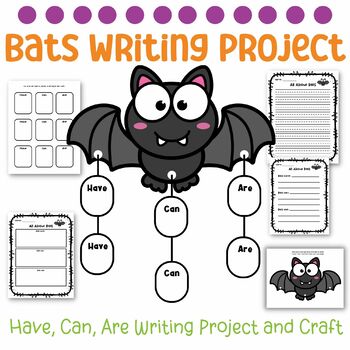
Halloween Writing Craft: All About Bats Research Project
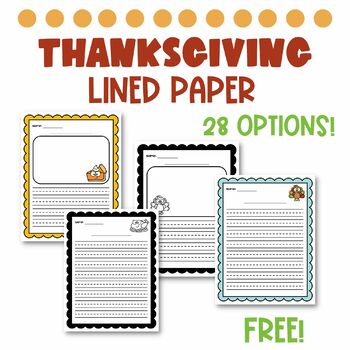
Thanksgiving Lined Paper Packet for Journals and Writing Projects
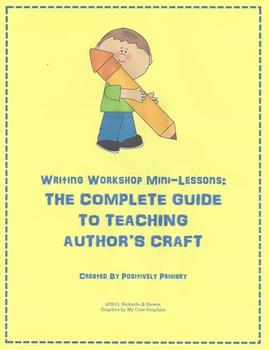
Writing Workshop Mini-Lessons: The Complete Guide to Teaching Author's Craft

Centro de escritura Mini Guía Spanish Literacy Recursos en español gratis
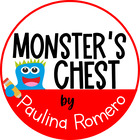
Monthly Writing Prompts - Themes FREEBIE
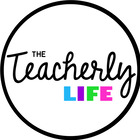
Fractured Fairy Tale Unit

Learning and Understanding Poetry Unit

A Poem A Day: National Poetry Month FREEBIE!

Haunted House Real Estate Ads

Poetry PowerPoint Lesson

When I Grow Up Writing Template

Personal Narrative Planning and Rough Draft template

FREE Beginning and End of the Year Writing for Any Grade Level

- Google Apps™
- We're hiring
- Help & FAQ
- Privacy policy
- Student privacy
- Terms of service
- Tell us what you think
MOSCOW - RUSSIA
Ewf b.v east west forwarding.
Edelveis, Right Entrance, 2nd Floor Davidkovskaja, 121352 Moscow, Russia
- Phone: +7 495 938-99-66
- Mobile: +7 495-997-0977
- Fax: +7 495 938-99-67
- email: [email protected]
- web: www.eastwestforwarding.com
Company Profile
- LIST WITH US
To: EWF B.V EAST WEST FORWARDING
Enter the security code:
+7 495 938-99-67
+7 495-997-0977
+7 495 938-99-66
Directory of Freight Forwarders, Cargo Agents, Shipping Companies, Air, Ocean, Land, Logistics and Transportation Brokers
- Yekaterinburg
- Novosibirsk
- Vladivostok

- Tours to Russia
- Practicalities
- Russia in Lists
Rusmania • Deep into Russia
Out of the Centre
Savvino-storozhevsky monastery and museum.

Zvenigorod's most famous sight is the Savvino-Storozhevsky Monastery, which was founded in 1398 by the monk Savva from the Troitse-Sergieva Lavra, at the invitation and with the support of Prince Yury Dmitrievich of Zvenigorod. Savva was later canonised as St Sabbas (Savva) of Storozhev. The monastery late flourished under the reign of Tsar Alexis, who chose the monastery as his family church and often went on pilgrimage there and made lots of donations to it. Most of the monastery’s buildings date from this time. The monastery is heavily fortified with thick walls and six towers, the most impressive of which is the Krasny Tower which also serves as the eastern entrance. The monastery was closed in 1918 and only reopened in 1995. In 1998 Patriarch Alexius II took part in a service to return the relics of St Sabbas to the monastery. Today the monastery has the status of a stauropegic monastery, which is second in status to a lavra. In addition to being a working monastery, it also holds the Zvenigorod Historical, Architectural and Art Museum.
Belfry and Neighbouring Churches

Located near the main entrance is the monastery's belfry which is perhaps the calling card of the monastery due to its uniqueness. It was built in the 1650s and the St Sergius of Radonezh’s Church was opened on the middle tier in the mid-17th century, although it was originally dedicated to the Trinity. The belfry's 35-tonne Great Bladgovestny Bell fell in 1941 and was only restored and returned in 2003. Attached to the belfry is a large refectory and the Transfiguration Church, both of which were built on the orders of Tsar Alexis in the 1650s.

To the left of the belfry is another, smaller, refectory which is attached to the Trinity Gate-Church, which was also constructed in the 1650s on the orders of Tsar Alexis who made it his own family church. The church is elaborately decorated with colourful trims and underneath the archway is a beautiful 19th century fresco.
Nativity of Virgin Mary Cathedral

The Nativity of Virgin Mary Cathedral is the oldest building in the monastery and among the oldest buildings in the Moscow Region. It was built between 1404 and 1405 during the lifetime of St Sabbas and using the funds of Prince Yury of Zvenigorod. The white-stone cathedral is a standard four-pillar design with a single golden dome. After the death of St Sabbas he was interred in the cathedral and a new altar dedicated to him was added.

Under the reign of Tsar Alexis the cathedral was decorated with frescoes by Stepan Ryazanets, some of which remain today. Tsar Alexis also presented the cathedral with a five-tier iconostasis, the top row of icons have been preserved.
Tsaritsa's Chambers

The Nativity of Virgin Mary Cathedral is located between the Tsaritsa's Chambers of the left and the Palace of Tsar Alexis on the right. The Tsaritsa's Chambers were built in the mid-17th century for the wife of Tsar Alexey - Tsaritsa Maria Ilinichna Miloskavskaya. The design of the building is influenced by the ancient Russian architectural style. Is prettier than the Tsar's chambers opposite, being red in colour with elaborately decorated window frames and entrance.

At present the Tsaritsa's Chambers houses the Zvenigorod Historical, Architectural and Art Museum. Among its displays is an accurate recreation of the interior of a noble lady's chambers including furniture, decorations and a decorated tiled oven, and an exhibition on the history of Zvenigorod and the monastery.
Palace of Tsar Alexis

The Palace of Tsar Alexis was built in the 1650s and is now one of the best surviving examples of non-religious architecture of that era. It was built especially for Tsar Alexis who often visited the monastery on religious pilgrimages. Its most striking feature is its pretty row of nine chimney spouts which resemble towers.

| Location | approximately 2km west of the city centre |
|---|---|
| Website | Monastery - http://savvastor.ru Museum - http://zvenmuseum.ru/ |
Plan your next trip to Russia
Ready-to-book tours.
Your holiday in Russia starts here. Choose and book your tour to Russia.
REQUEST A CUSTOMISED TRIP
Looking for something unique? Create the trip of your dreams with the help of our experts.

IMAGES
VIDEO
COMMENTS
This will help keep the unit focused on a skill or two that you can measure at the beginning and end (pretest/posttest). If you're using Common Core to write your targets, you won't find a lot of poetry-friendly areas, but certainly consider the language standard: " CCSS.ELA-LITERACY.L.9-10.5. Demonstrate understanding of figurative language ...
This poetry unit for high school includes slideshow lessons, word wall activities, vocabulary anchor charts, bookmarks, annotation activities, and informational handouts. During this 2-week unit, students will learn how to fluently read and analyze poetry. High School Poetry Lessons.
Here are 12 great songs to analyze if you aren't sure where to start: "Across the Universe" by the Beatles. "Angel" by Sarah McLachlan. "Blank Space" by Taylor Swift. "Chasing Pavements" by Adele. "Infinity" by Mariah Carey. "Stereo Hearts" by Gym Class Heroes. "Counting Stars" by One Republic.
In this High School Poetry Packet, your students will read, study, and analyze six famous poems! Perfect for any Poetry Unit! This packet is a wonderful tool because you can have students complete the literary analysis questions in a variety of ways: whole-class, independently, or collaboratively. The 6 poems included in this packet are:
Creative Writing Poetry UnitThis creative writing high school poetry unit has 18 detailed lessons that lead students through fun exercises done in a workbook/journal to complete a p. Subjects: Creative Writing, English Language Arts, Poetry. Grades: 9 th - 12 th. Types: Activities, Lesson, Unit Plans.
Tags: writing the community. Here are five lesson plans from the 2022-2023 school year for middle and high school students, from our Writing the Community teaching artists! A Poem About Joy: In this lesson plan, inspired by Ross Gay's "Sorrow Is Not My Name," Teré Fowler-Chapman asks young poets to come up with a list of things that bring them ...
Description. Help your students to LOVE writing creatively with this 3-Week Poetry Unit and 4-Week Creative Writing Unit. Students write many different types of poetry, analyze poetry by learning poetic devices and terms, and create a beautiful poetry portfolio. In the Creative Writing Unit, students focus on the 6 Traits of Effective Writing ...
But for now, I hope the ideas below will inspire you to try these within your own larger poetry unit, or simply as a refreshing creative writing activity. Clint Smith. Adelaide Crapsey. Sounds of Silence Poems. An old-but-good poetry resource. Cold Water Poems. Billy Collins. Naomi Shihab Nye. Metaphor Dice.
Help your students to LOVE writing creatively with this 3-Week Poetry Unit and 4-Week Creative Writing Unit. Students write many different types of poetry, analyze poetry by learning poetic devices and terms, and create a beautiful poetry portfolio. In the Creative Writing Unit, students focus on th...
Classroom Poetry Idea: Write Lipograms. This month I've been collaborating with the amazing Melissa Alter Smith over at Teach Living Poets to work on contemporary poetry activities for The Lighthouse. I love her post, " Letter Play ," sharing ways to get students thinking about how to use different letter structures in their poems.
Both middle and and high school students can benefit from these super fun poetry activities! The middle school poetry unit below helps students develop close reading, critical thinking, and creative writing skills. This unit includes links to over 30 poems (mentor texts) that are relevant to the lives of students and great for introducing ...
She has taught high school English for 10+ years in Dallas, Chicago, and New York City and holds a M.A. in Literature from Northwestern University. She has always had a connection to the written word-- through songwriting, screenplay writing, and essay writing-- and she enjoys the process of teaching students how to express their ideas.
Maybe you're starting your first poetry unit, or maybe you need a way to engage students who claim to dislike it. In this post, you'll find nine fun poetry lessons for secondary. 1. Creative Writing. Help students study the importance of text structure as they write nonfiction-inspired poetry. Try blending elements of prose, verse, picture ...
This creative writing high school POETRY WRITING UNIT has 18 detailed lessons that lead students through fun exercises done in a workbook/journal to complete a poetry portfolio of 7 poems. It is a no prep, print and go (or put on Google Classroom) resource.
Finally, instruct students to glue their poem into place on a colorful piece of paper and decorate your room with the beauty and power of poetry. 4. Poetry Escape Room. A poetry escape room is the most engaging and fun way to introduce or review poetry with your students. Escape rooms by nature are hands on and engaging.
Studying poetry with high schoolers can be really fun. There are so many different forms of poetry — yes, including pop songs! — and writing poems is an incredible creative outlet for teenagers. Here's a rundown of fun poetry games and activities, which can work for standalone high school lessons or as warm-ups to a writing assignment.
For students who are poets (and may or may not know it!), these resources, tips, and tricks will make learning and teaching poetry engaging and fun.
Find details about every creative writing competition—including poetry contests, short story competitions, essay contests, awards for novels, grants for translators, and more—that we've published in the Grants & Awards section of Poets & Writers Magazine during the past year. We carefully review the practices and policies of each contest before including it in the Writing Contests ...
Poetry Mini Unit. A 1 week mini unit on poetry writing, suitable for grades 4-6. Includes: - 5 styles of poems (acrostic, haiku, limerick, concrete, cinquain)- 32 slide google slides doc- Organized lessons (explanations on how to write each poem, do it as a class, timers for students to write on their own).
GENERAL AFFIDAVIT Russian Federation..... ) Moscow Oblast ..... ) City of Moscow.....
Cities near Elektrostal. Places of interest. Pavlovskiy Posad Noginsk. Travel guide resource for your visit to Elektrostal. Discover the best of Elektrostal so you can plan your trip right.
The Purdue On-Campus Writing Lab and Purdue Online Writing Lab assist clients in their development as writers—no matter what their skill level—with on-campus consultations, online participation, and community engagement. The Purdue Writing Lab serves the Purdue, West Lafayette, campus and coordinates with local literacy initiatives.
Writing Units Bundle Narrative Opinion Persuasive Biography Informative. Teach2Tell. $58.00 $115.00. Thanksgiving Writing and Craft! How to Catch a Turkey Free Activity! Created by. Bugs and Buttercups. I have created a FREE "How to Catch a Turkey" Thanksgiving Writing Project and Craft Packet! These writing templates would be perfect to ...
EWF B.V EAST WEST FORWARDING. Edelveis, Right Entrance, 2nd Floor Davidkovskaja, 121352 Moscow, Russia. Phone: +7 495 938-99-66; Mobile: +7 495-997-0977
Zvenigorod's most famous sight is the Savvino-Storozhevsky Monastery, which was founded in 1398 by the monk Savva from the Troitse-Sergieva Lavra, at the invitation and with the support of Prince Yury Dmitrievich of Zvenigorod. Savva was later canonised as St Sabbas (Savva) of Storozhev. The monastery late flourished under the reign of Tsar ...